Living with a canine companion is one of life’s greatest joys, but for many, the reality of dog hair covering furniture, clothes, and floors can be a significant deterrent. Even more challenging are dog allergies, which can turn the dream of pet ownership into a constant battle against sniffles, sneezes, and itchy eyes. This is where the concept of “dogs that don’t shed at all” becomes incredibly appealing. While no dog is truly 100% allergen-free or sheds absolutely zero hair – just like humans, they naturally lose some skin cells and hair – certain breeds shed so minimally that they are often considered “non-shedding” or “hypoallergenic.” These remarkable breeds offer a fantastic solution for individuals and families seeking a cleaner home environment or struggling with pet allergies, allowing them to experience the profound companionship a dog offers without constant maintenance or allergic reactions.
Understanding “Non-Shedding”: The Reality of Low-Shedding Dogs
When people search for “dogs that don’t shed at all,” they are typically looking for breeds that produce very little dander and hair, thereby reducing potential allergens in the home. It’s important to clarify that the term “hypoallergenic” is somewhat misleading because all dogs produce allergens. The primary allergens are proteins found in a dog’s skin cells (dander), saliva, and urine, not just their hair. However, dogs that shed less hair also tend to release less dander into the environment, as dander often clings to loose hair. This significantly reduces the concentration of allergens in the home, making these breeds a much better fit for people with sensitivities.
Breeds often labeled as non-shedding usually have hair that continues to grow, similar to human hair, rather than having a short growth cycle that results in frequent shedding. This type of coat requires regular grooming, often professional trimming, to prevent matting and keep it healthy. Understanding this distinction is crucial: while you won’t find a dog that sheds no hair, you can find many wonderful breeds that shed so minimally that they are considered “practically non-shedding,” offering a much-desired solution for cleaner homes and fewer allergy triggers. For those seeking a companion without the constant upkeep of shedding, exploring good small house dogs that don’t shed can be a great starting point.
Top Dog Breeds That Minimally Shed (Practically “Don’t Shed At All”)
Here is a comprehensive list of dog breeds renowned for their minimal shedding, making them excellent choices for allergy sufferers and those who prefer a tidy home. Each breed has unique characteristics, exercise needs, and grooming requirements.
1. Poodle
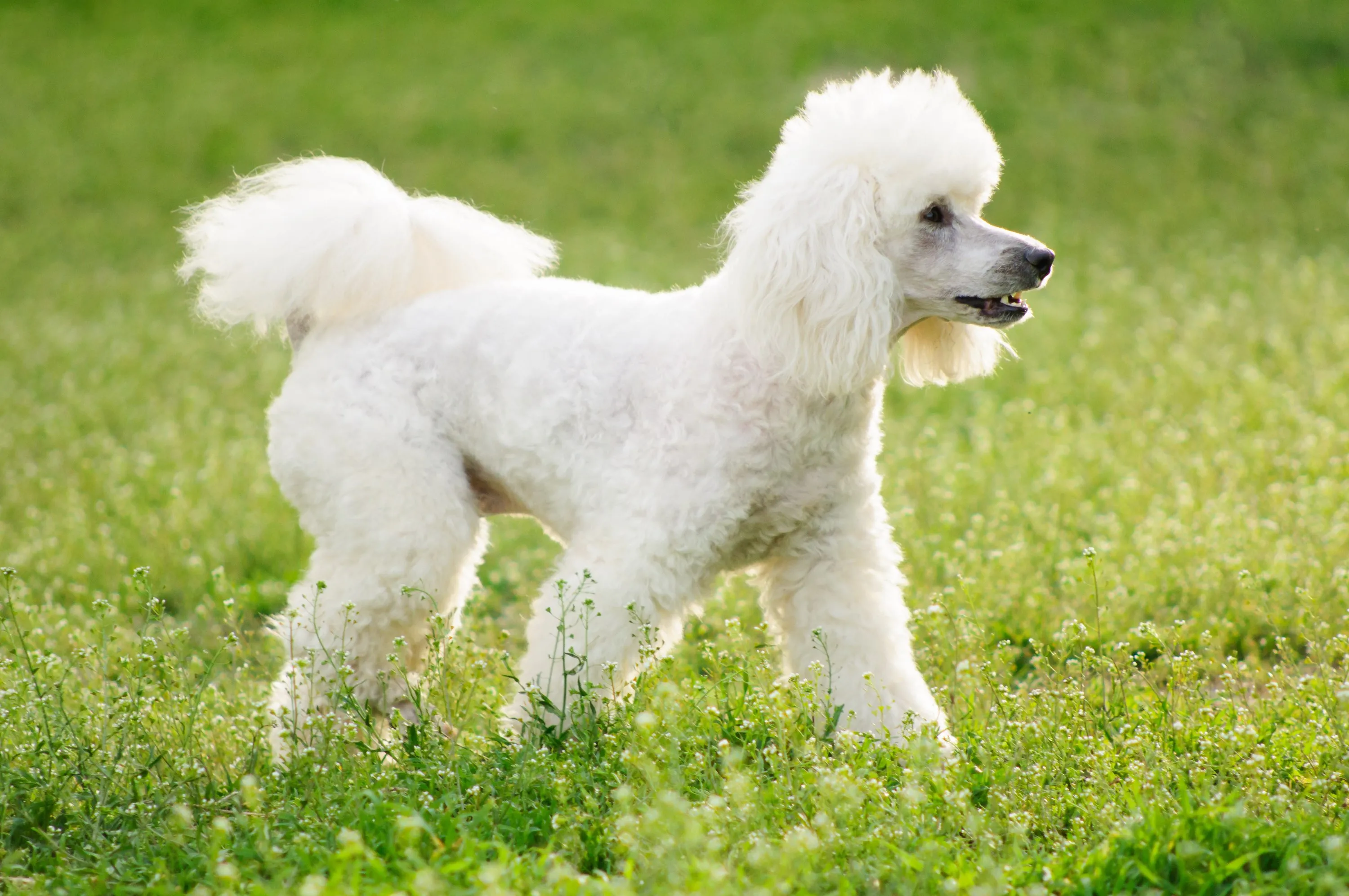 White Poodle gracefully walking through lush green grassPoodles are perhaps the most famous of the low-shedding breeds, celebrated for their elegance and keen intelligence. Available in three sizes—Standard, Miniature, and Toy—they all possess the same dense, curly coat that sheds very little. Originally bred as water retrievers, Standard Poodles are robust and active, while their smaller counterparts, Miniature and Toy Poodles, were developed for companionship. Beyond their non-shedding coats, Poodles are highly trainable and eager to please, making them excellent family pets. Their intelligence also means they thrive on mental stimulation and consistent training. Regular grooming, including brushing several times a week and professional clipping every 4-6 weeks, is essential to prevent their curls from matting.
White Poodle gracefully walking through lush green grassPoodles are perhaps the most famous of the low-shedding breeds, celebrated for their elegance and keen intelligence. Available in three sizes—Standard, Miniature, and Toy—they all possess the same dense, curly coat that sheds very little. Originally bred as water retrievers, Standard Poodles are robust and active, while their smaller counterparts, Miniature and Toy Poodles, were developed for companionship. Beyond their non-shedding coats, Poodles are highly trainable and eager to please, making them excellent family pets. Their intelligence also means they thrive on mental stimulation and consistent training. Regular grooming, including brushing several times a week and professional clipping every 4-6 weeks, is essential to prevent their curls from matting.
2. Yorkshire Terrier
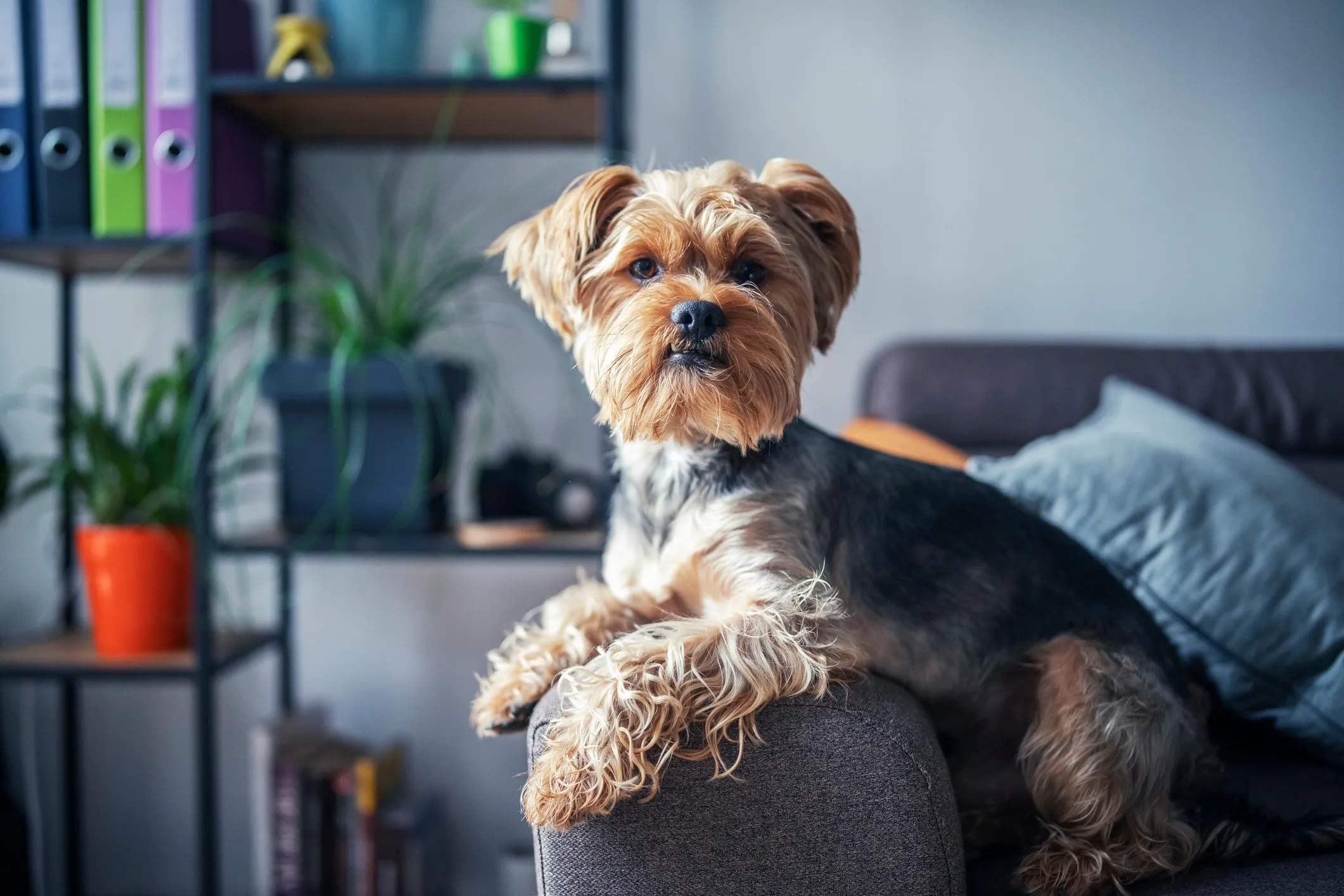 Blue and tan Yorkie resting comfortably on an armchairTiny but mighty, Yorkshire Terriers, or Yorkies, are spirited companions known for their silky, flowing coats that are surprisingly low-shedding. Their fine hair is more akin to human hair, requiring daily brushing to prevent tangles and maintain its lustrous appearance. Despite their small stature, Yorkies possess bold personalities and are incredibly affectionate with their families. They adapt well to various living situations, from bustling city apartments to larger homes, provided they receive ample attention and moderate exercise. For individuals seeking dogs that don’t shed and stay small, the Yorkie is an ideal choice, embodying a big personality in a compact, low-shedding package.
Blue and tan Yorkie resting comfortably on an armchairTiny but mighty, Yorkshire Terriers, or Yorkies, are spirited companions known for their silky, flowing coats that are surprisingly low-shedding. Their fine hair is more akin to human hair, requiring daily brushing to prevent tangles and maintain its lustrous appearance. Despite their small stature, Yorkies possess bold personalities and are incredibly affectionate with their families. They adapt well to various living situations, from bustling city apartments to larger homes, provided they receive ample attention and moderate exercise. For individuals seeking dogs that don’t shed and stay small, the Yorkie is an ideal choice, embodying a big personality in a compact, low-shedding package.
3. Shih Tzu
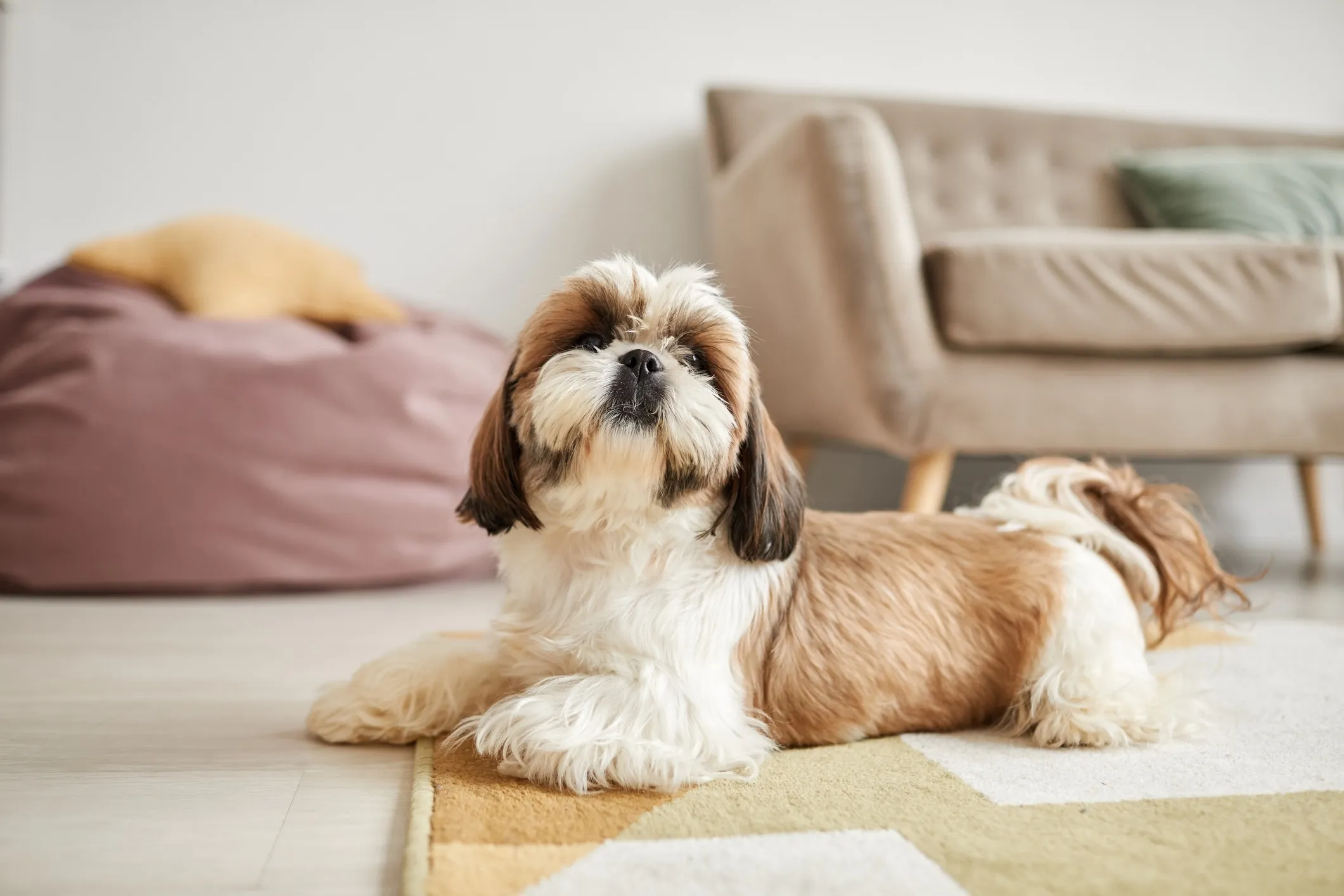 Brown and white Shih Tzu lounging on a living room floorThe Shih Tzu is an ancient breed known for its luxurious long coat and friendly, outgoing temperament. These charming “lion dogs” were bred purely for companionship and excel at being adored. Their hair is also similar to human hair, meaning it sheds minimally but requires consistent daily grooming to prevent matting. Due to their distinctive flat faces, Shih Tzus can be prone to certain health issues, including breathing difficulties in hot weather and tear staining. Regular cleaning around the eyes with dog-specific wipes can help manage tear stains. Despite these considerations, their affectionate nature and minimal shedding make them a popular choice.
Brown and white Shih Tzu lounging on a living room floorThe Shih Tzu is an ancient breed known for its luxurious long coat and friendly, outgoing temperament. These charming “lion dogs” were bred purely for companionship and excel at being adored. Their hair is also similar to human hair, meaning it sheds minimally but requires consistent daily grooming to prevent matting. Due to their distinctive flat faces, Shih Tzus can be prone to certain health issues, including breathing difficulties in hot weather and tear staining. Regular cleaning around the eyes with dog-specific wipes can help manage tear stains. Despite these considerations, their affectionate nature and minimal shedding make them a popular choice.
4. Miniature Schnauzer
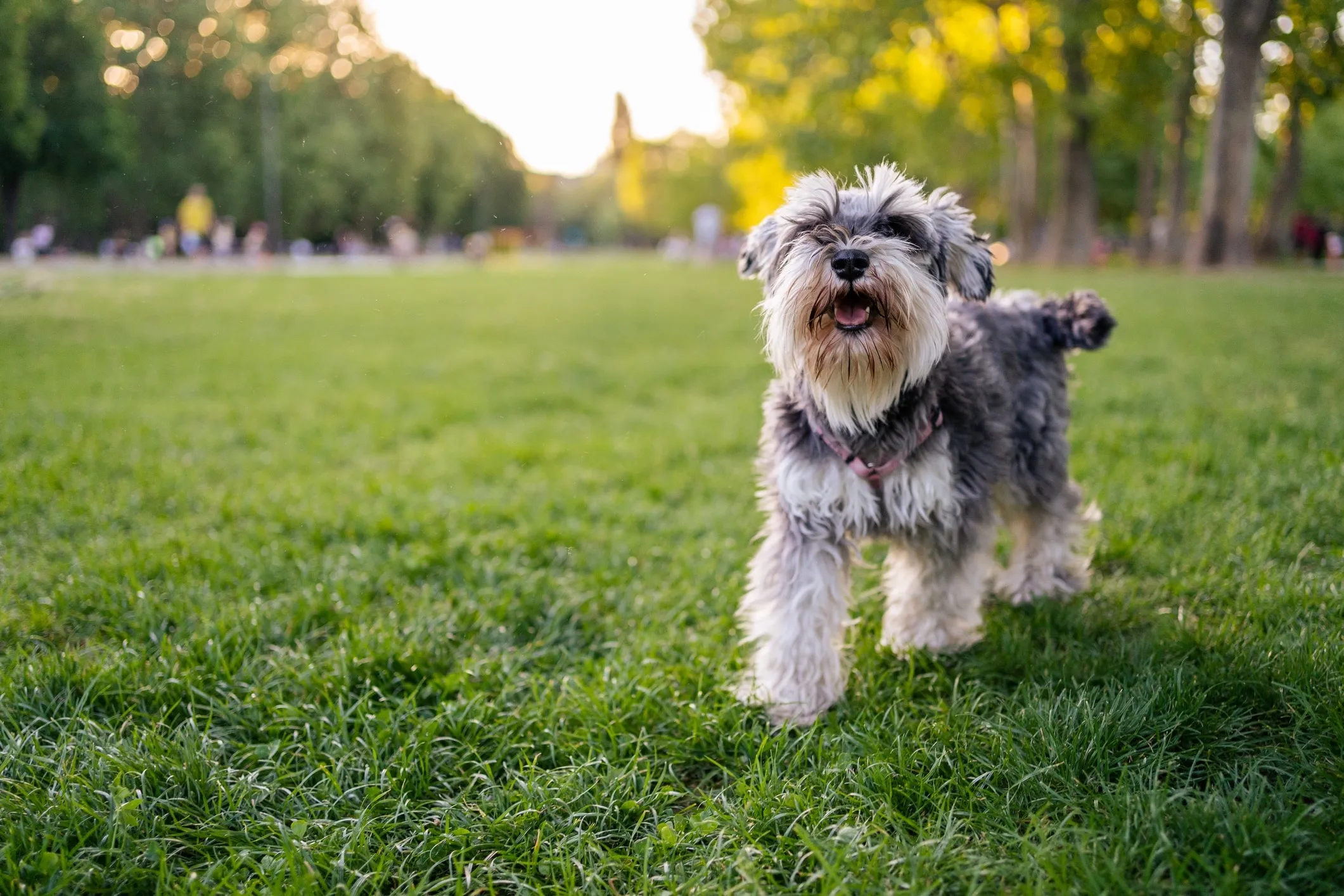 Salt and pepper Miniature Schnauzer wearing a pink harness in a parkMiniature Schnauzers are robust, intelligent, and famously spirited dogs that boast a wiry, low-shedding coat. Their distinctive beard and eyebrows give them a unique, charming expression. These dogs are highly adaptable and thrive in various environments, from urban apartments to country homes, as long as they receive at least an hour of active exercise daily. They are known for their strong personalities and loyalty, making excellent watchdogs. Their double coat needs regular brushing and professional grooming, often involving hand-stripping or clipping, to maintain its texture and minimize shedding.
Salt and pepper Miniature Schnauzer wearing a pink harness in a parkMiniature Schnauzers are robust, intelligent, and famously spirited dogs that boast a wiry, low-shedding coat. Their distinctive beard and eyebrows give them a unique, charming expression. These dogs are highly adaptable and thrive in various environments, from urban apartments to country homes, as long as they receive at least an hour of active exercise daily. They are known for their strong personalities and loyalty, making excellent watchdogs. Their double coat needs regular brushing and professional grooming, often involving hand-stripping or clipping, to maintain its texture and minimize shedding.
5. Standard Schnauzer
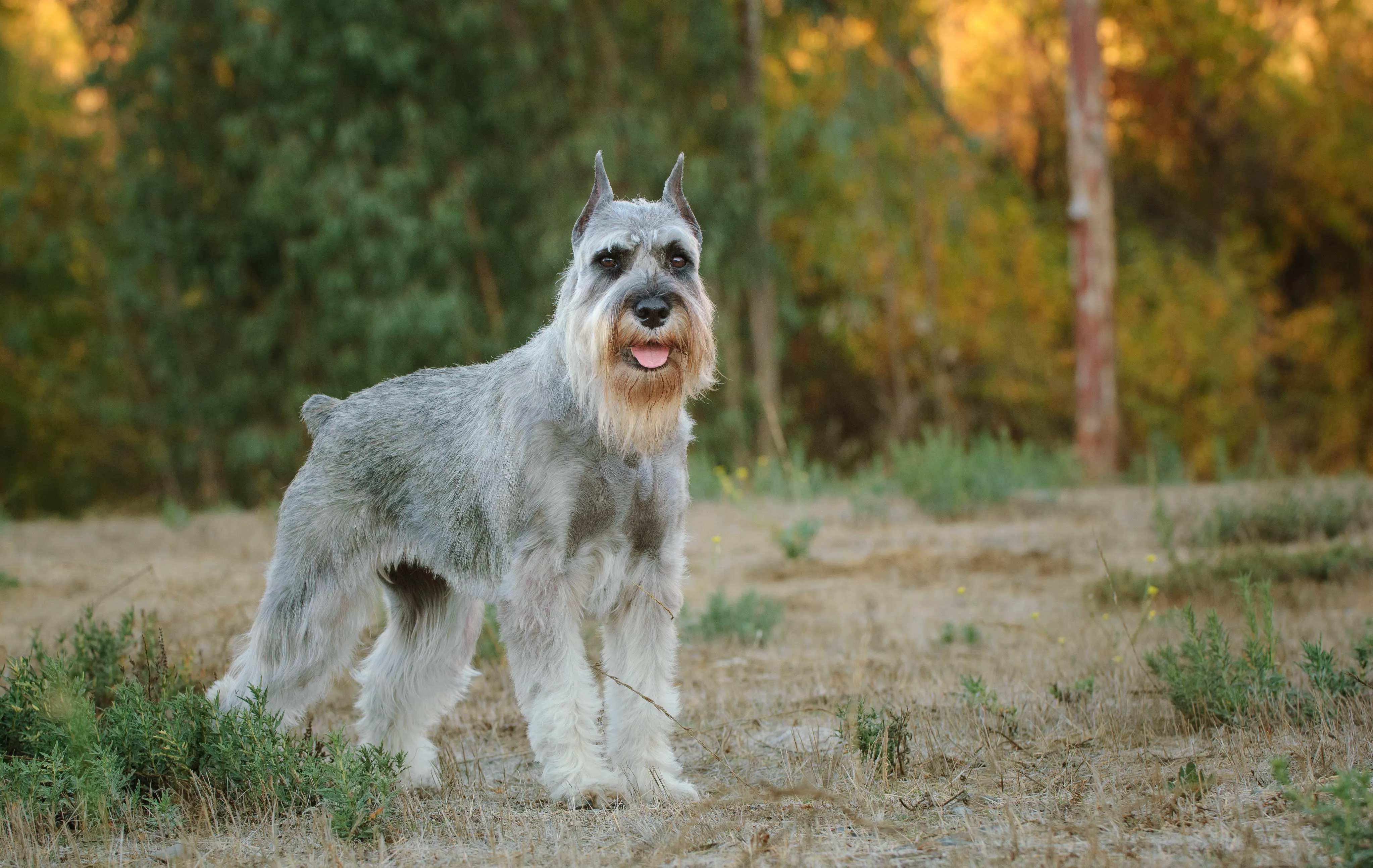 Gray Standard Schnauzer standing alert in a fieldThe Standard Schnauzer shares many admirable traits with its miniature cousin but in a larger, more powerful build. These intelligent and protective dogs are known for their hard, wiry, low-shedding coats. Standard Schnauzers are active and require substantial daily exercise, enjoying long walks, games of fetch, and mental challenges. They are highly intelligent, making them quite trainable, but they also possess a strong will, requiring a consistent and firm hand in training. Their coats need regular brushing and professional grooming to keep them neat and dander-free.
Gray Standard Schnauzer standing alert in a fieldThe Standard Schnauzer shares many admirable traits with its miniature cousin but in a larger, more powerful build. These intelligent and protective dogs are known for their hard, wiry, low-shedding coats. Standard Schnauzers are active and require substantial daily exercise, enjoying long walks, games of fetch, and mental challenges. They are highly intelligent, making them quite trainable, but they also possess a strong will, requiring a consistent and firm hand in training. Their coats need regular brushing and professional grooming to keep them neat and dander-free.
6. Giant Schnauzer
 Wet black Giant Schnauzer wearing a blue bow collar in a parkAs the largest of the Schnauzer family, Giant Schnauzers are impressive, powerful dogs with a commanding presence and a low-shedding, dense, wiry coat. Despite their size, they are affectionate and loyal to their families, though they can be reserved with strangers. These high-energy dogs demand extensive exercise, including daily long walks, runs, or challenging hikes, to keep them physically and mentally satisfied. Without sufficient activity, they can become bored and destructive. Their protective nature also makes them excellent guardians. Like other Schnauzers, they require consistent grooming to maintain their coat.
Wet black Giant Schnauzer wearing a blue bow collar in a parkAs the largest of the Schnauzer family, Giant Schnauzers are impressive, powerful dogs with a commanding presence and a low-shedding, dense, wiry coat. Despite their size, they are affectionate and loyal to their families, though they can be reserved with strangers. These high-energy dogs demand extensive exercise, including daily long walks, runs, or challenging hikes, to keep them physically and mentally satisfied. Without sufficient activity, they can become bored and destructive. Their protective nature also makes them excellent guardians. Like other Schnauzers, they require consistent grooming to maintain their coat.
7. Bichon Frise
 White Bichon Frise dog looking up while sitting in the grassThe Bichon Frise is a cheerful, playful, and affectionate small dog with a distinctive curly, powder-puff coat that sheds minimally. Their joyful demeanor and adaptability make them wonderful companions for families, singles, and seniors alike. Bichons are highly intelligent and eager to learn, responding well to positive reinforcement training. Their fluffy double coat requires daily brushing to prevent mats and regular professional grooming to keep its signature shape. While they don’t shed much, their coat needs diligent care to remain clean and healthy, underscoring the importance of understanding the grooming needs of smallest dog breeds that don’t shed.
White Bichon Frise dog looking up while sitting in the grassThe Bichon Frise is a cheerful, playful, and affectionate small dog with a distinctive curly, powder-puff coat that sheds minimally. Their joyful demeanor and adaptability make them wonderful companions for families, singles, and seniors alike. Bichons are highly intelligent and eager to learn, responding well to positive reinforcement training. Their fluffy double coat requires daily brushing to prevent mats and regular professional grooming to keep its signature shape. While they don’t shed much, their coat needs diligent care to remain clean and healthy, underscoring the importance of understanding the grooming needs of smallest dog breeds that don’t shed.
8. Chinese Crested
 Black hairless Chinese Crested dog looking at the cameraChinese Crested dogs are unique in appearance and come in two distinct varieties: hairless and powderpuff. The Hairless Crested has smooth skin with tufts of hair on its head, tail, and paws, while the Powderpuff variety is covered in a soft, silky coat. Both varieties are considered low-shedding and hypoallergenic. These playful and affectionate dogs are devoted companions, often forming strong bonds with their owners. Their skin (for the hairless variety) requires sun protection and moisturizing, while the Powderpuff’s coat needs regular brushing to prevent tangles.
Black hairless Chinese Crested dog looking at the cameraChinese Crested dogs are unique in appearance and come in two distinct varieties: hairless and powderpuff. The Hairless Crested has smooth skin with tufts of hair on its head, tail, and paws, while the Powderpuff variety is covered in a soft, silky coat. Both varieties are considered low-shedding and hypoallergenic. These playful and affectionate dogs are devoted companions, often forming strong bonds with their owners. Their skin (for the hairless variety) requires sun protection and moisturizing, while the Powderpuff’s coat needs regular brushing to prevent tangles.
9. Portuguese Water Dog
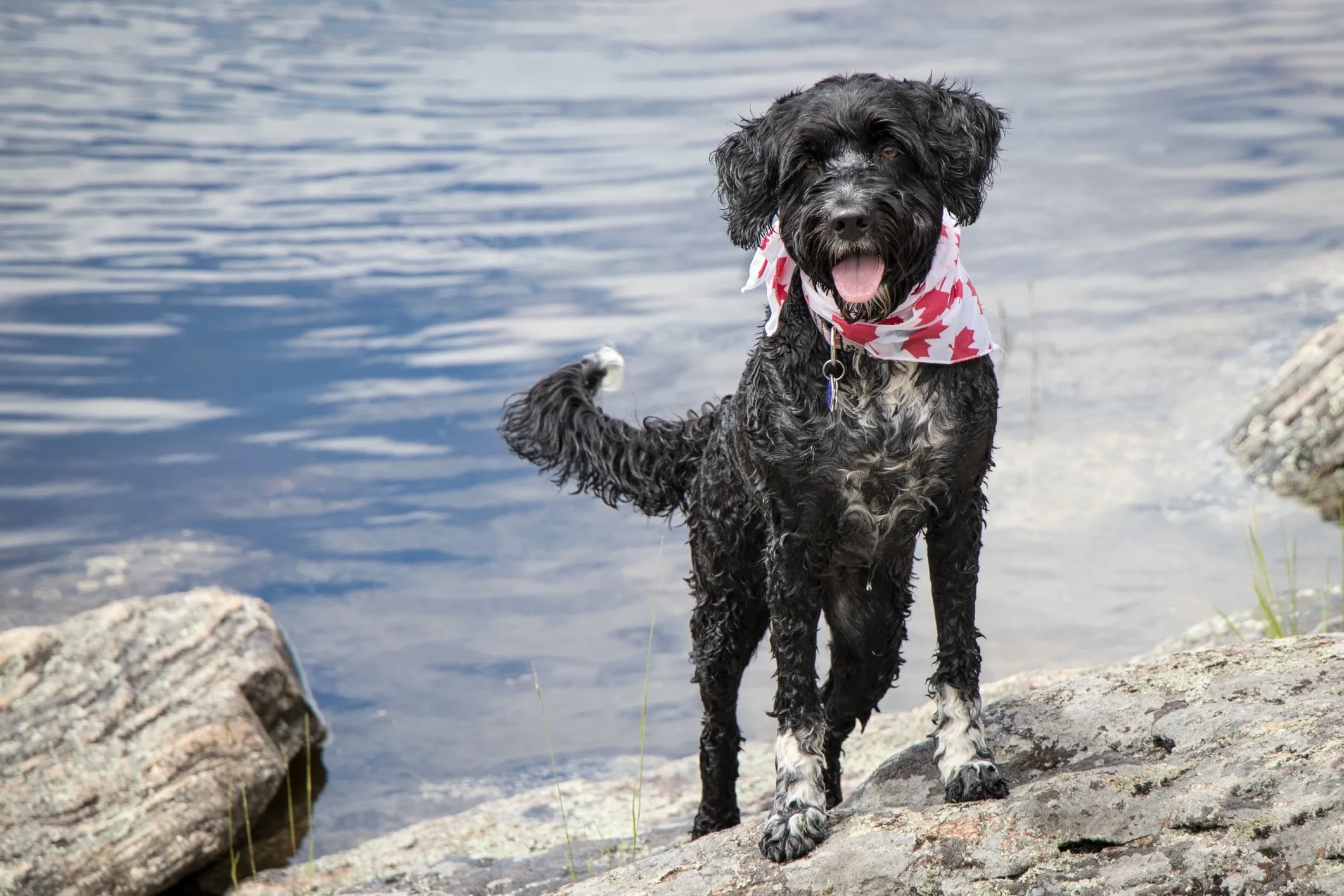 Black and white Portuguese Water Dog wearing a red maple leaf bandana in front of waterOriginally bred to assist fishermen, the Portuguese Water Dog is a medium-sized, athletic breed known for its thick, curly, waterproof coat that sheds very little. They are highly intelligent, energetic, and eager to please, making them exceptionally trainable. These dogs thrive on activity and mental stimulation, excelling in dog sports and enjoying activities like swimming. Regular exercise is crucial to their well-being. Their dense coat requires frequent brushing and professional grooming to prevent matting and keep it healthy.
Black and white Portuguese Water Dog wearing a red maple leaf bandana in front of waterOriginally bred to assist fishermen, the Portuguese Water Dog is a medium-sized, athletic breed known for its thick, curly, waterproof coat that sheds very little. They are highly intelligent, energetic, and eager to please, making them exceptionally trainable. These dogs thrive on activity and mental stimulation, excelling in dog sports and enjoying activities like swimming. Regular exercise is crucial to their well-being. Their dense coat requires frequent brushing and professional grooming to prevent matting and keep it healthy.
10. Labradoodle
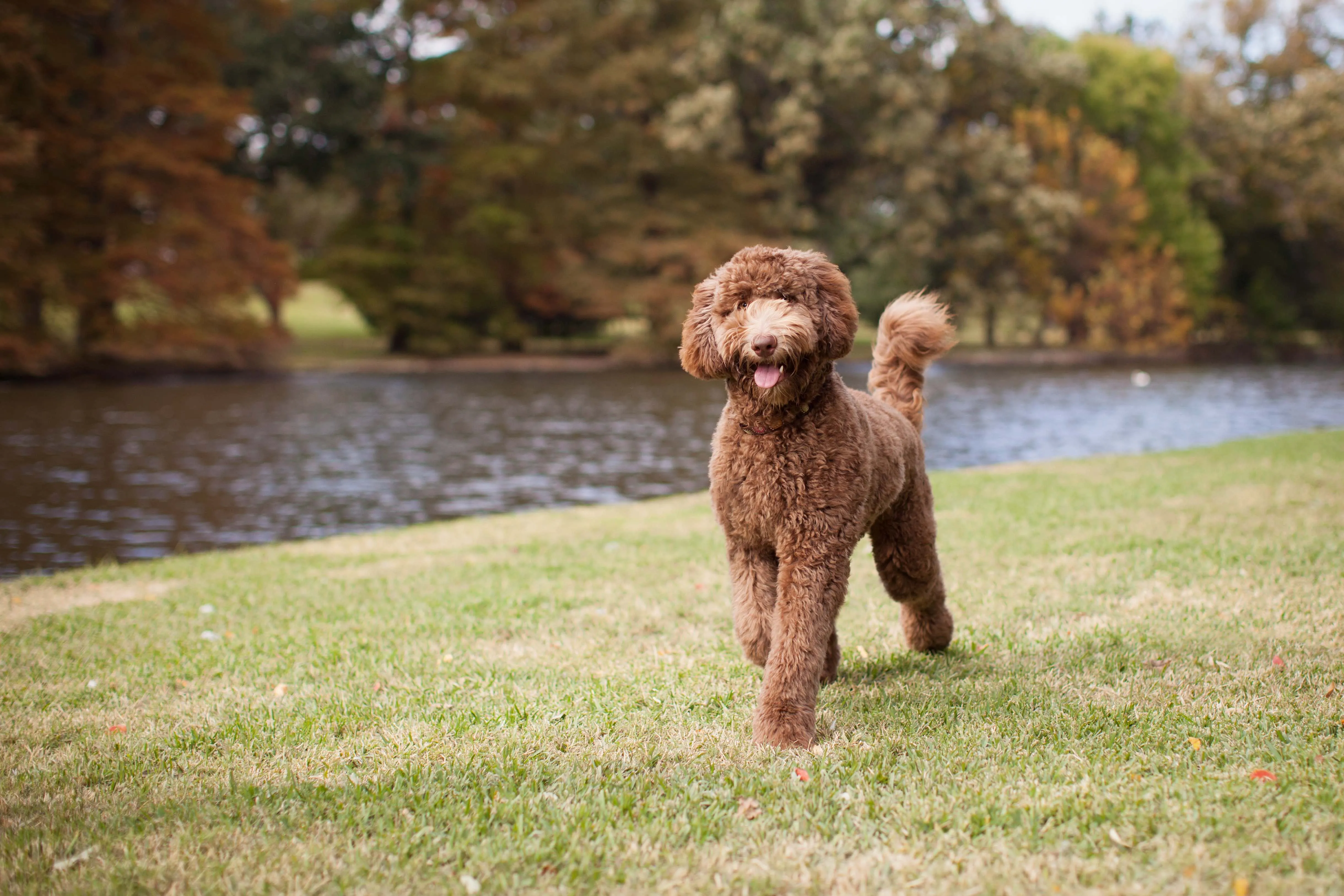 Brown Standard Labradoodle walking through a parkA popular crossbreed between a Labrador Retriever and a Poodle, the Labradoodle was originally developed to be a hypoallergenic guide dog. These friendly, intelligent dogs inherit the best traits from both parents, making them excellent family pets. Their coats can vary from wavy to curly, and while some are very low-shedding, it’s important to note that the degree of shedding can vary depending on their genetic inheritance. Consistent training and early socialization are important to harness their intelligence and ensure they are well-behaved companions. Their coat requires regular brushing and professional grooming to prevent mats.
Brown Standard Labradoodle walking through a parkA popular crossbreed between a Labrador Retriever and a Poodle, the Labradoodle was originally developed to be a hypoallergenic guide dog. These friendly, intelligent dogs inherit the best traits from both parents, making them excellent family pets. Their coats can vary from wavy to curly, and while some are very low-shedding, it’s important to note that the degree of shedding can vary depending on their genetic inheritance. Consistent training and early socialization are important to harness their intelligence and ensure they are well-behaved companions. Their coat requires regular brushing and professional grooming to prevent mats.
11. Goldendoodle
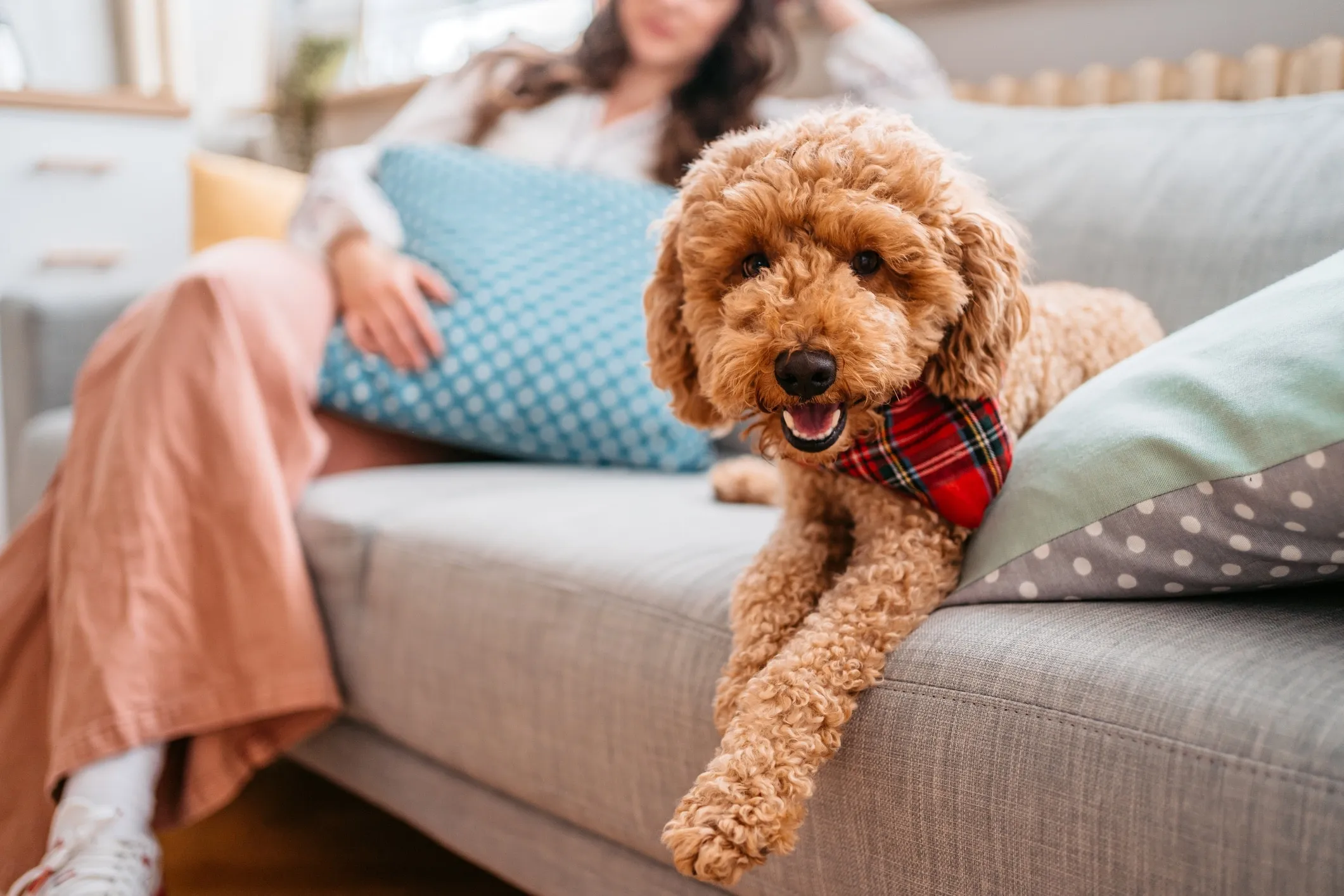 Goldendoodle lying on a couch with a person in the backgroundAnother beloved “doodle” breed, the Goldendoodle is a cross between a Golden Retriever and a Poodle. Like Labradoodles, they are cherished for their friendly nature, intelligence, and low-shedding coats. While many sport the classic golden hue of their Golden Retriever parent, their coats can come in various colors and textures, all typically requiring frequent grooming with a slicker brush to prevent matting. They are generally adaptable and get along well with children and other pets, making them wonderful additions to active families.
Goldendoodle lying on a couch with a person in the backgroundAnother beloved “doodle” breed, the Goldendoodle is a cross between a Golden Retriever and a Poodle. Like Labradoodles, they are cherished for their friendly nature, intelligence, and low-shedding coats. While many sport the classic golden hue of their Golden Retriever parent, their coats can come in various colors and textures, all typically requiring frequent grooming with a slicker brush to prevent matting. They are generally adaptable and get along well with children and other pets, making them wonderful additions to active families.
12. Lagotto Romagnolo
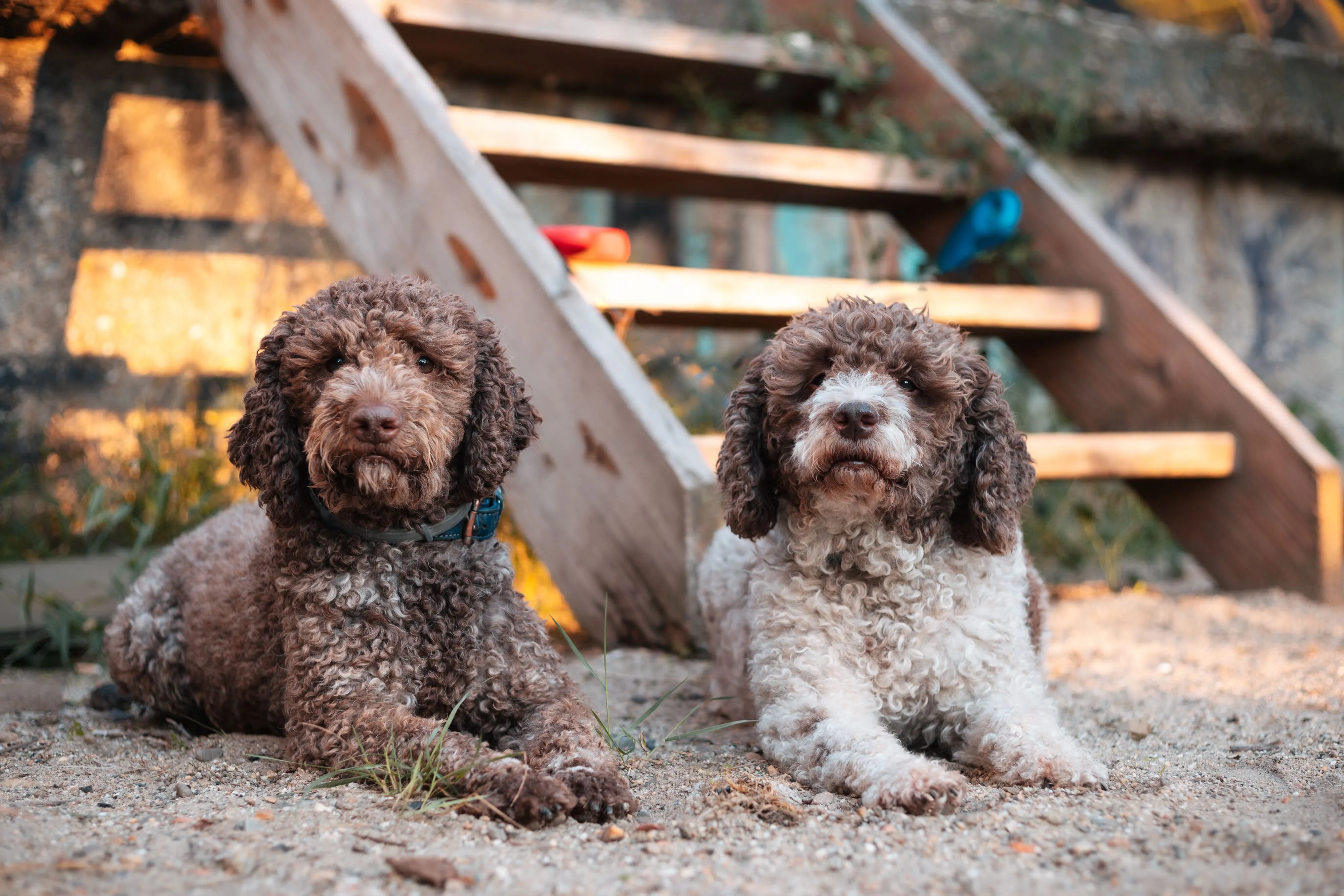 Two Lagotto Romagnolo dogs lying in dirt, looking at the cameraThe Lagotto Romagnolo is an ancient Italian breed, originally water retrievers, known for their dense, curly, woolly coat that is low-shedding and waterproof. They are intelligent, affectionate, and relatively easy to train, often excelling in scent work due to their historical role as truffle hunters. Lagotti are generally good with children and other pets, making them suitable family dogs. Their unique coat requires specific grooming to maintain its structure and prevent matting, often involving hand-stripping or regular clipping.
Two Lagotto Romagnolo dogs lying in dirt, looking at the cameraThe Lagotto Romagnolo is an ancient Italian breed, originally water retrievers, known for their dense, curly, woolly coat that is low-shedding and waterproof. They are intelligent, affectionate, and relatively easy to train, often excelling in scent work due to their historical role as truffle hunters. Lagotti are generally good with children and other pets, making them suitable family dogs. Their unique coat requires specific grooming to maintain its structure and prevent matting, often involving hand-stripping or regular clipping.
13. Affenpinscher
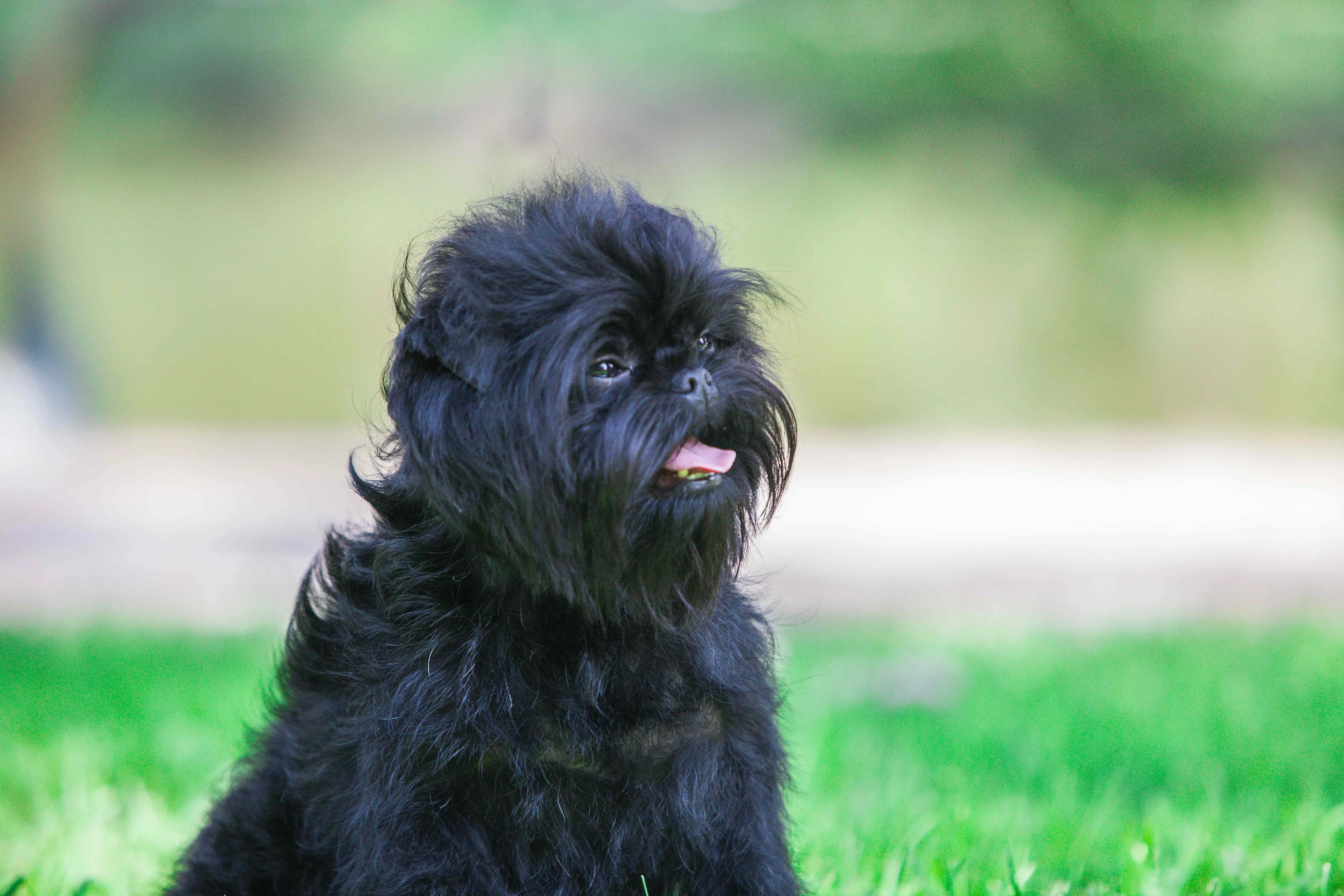 Close-up of a black Affenpinscher dogAffenpinschers are small, charming dogs known for their monkey-like expressions and dense, wiry coats that shed minimally. These confident and curious little dogs are full of personality, often described as mischievous but endearing. Their coat requires regular care, including at-home brushing and occasional professional stripping (a process of pulling out dead hair by the root) to maintain its characteristic texture and reduce shedding.
Close-up of a black Affenpinscher dogAffenpinschers are small, charming dogs known for their monkey-like expressions and dense, wiry coats that shed minimally. These confident and curious little dogs are full of personality, often described as mischievous but endearing. Their coat requires regular care, including at-home brushing and occasional professional stripping (a process of pulling out dead hair by the root) to maintain its characteristic texture and reduce shedding.
14. Irish Water Spaniel
 Profile view of a brown Irish Water SpanielThe Irish Water Spaniel is a distinctive and highly energetic water dog breed, recognized by its tight, crisp liver-colored curls that shed minimally. These intelligent, playful, and highly trainable dogs were originally bred for retrieving game from water. They possess a strong desire to work and please, making them responsive to training. Due to their high energy levels, they require substantial daily exercise to remain happy and healthy. Regular grooming is essential to keep their unique double coat in good condition, especially after swimming.
Profile view of a brown Irish Water SpanielThe Irish Water Spaniel is a distinctive and highly energetic water dog breed, recognized by its tight, crisp liver-colored curls that shed minimally. These intelligent, playful, and highly trainable dogs were originally bred for retrieving game from water. They possess a strong desire to work and please, making them responsive to training. Due to their high energy levels, they require substantial daily exercise to remain happy and healthy. Regular grooming is essential to keep their unique double coat in good condition, especially after swimming.
15. Aussiedoodle
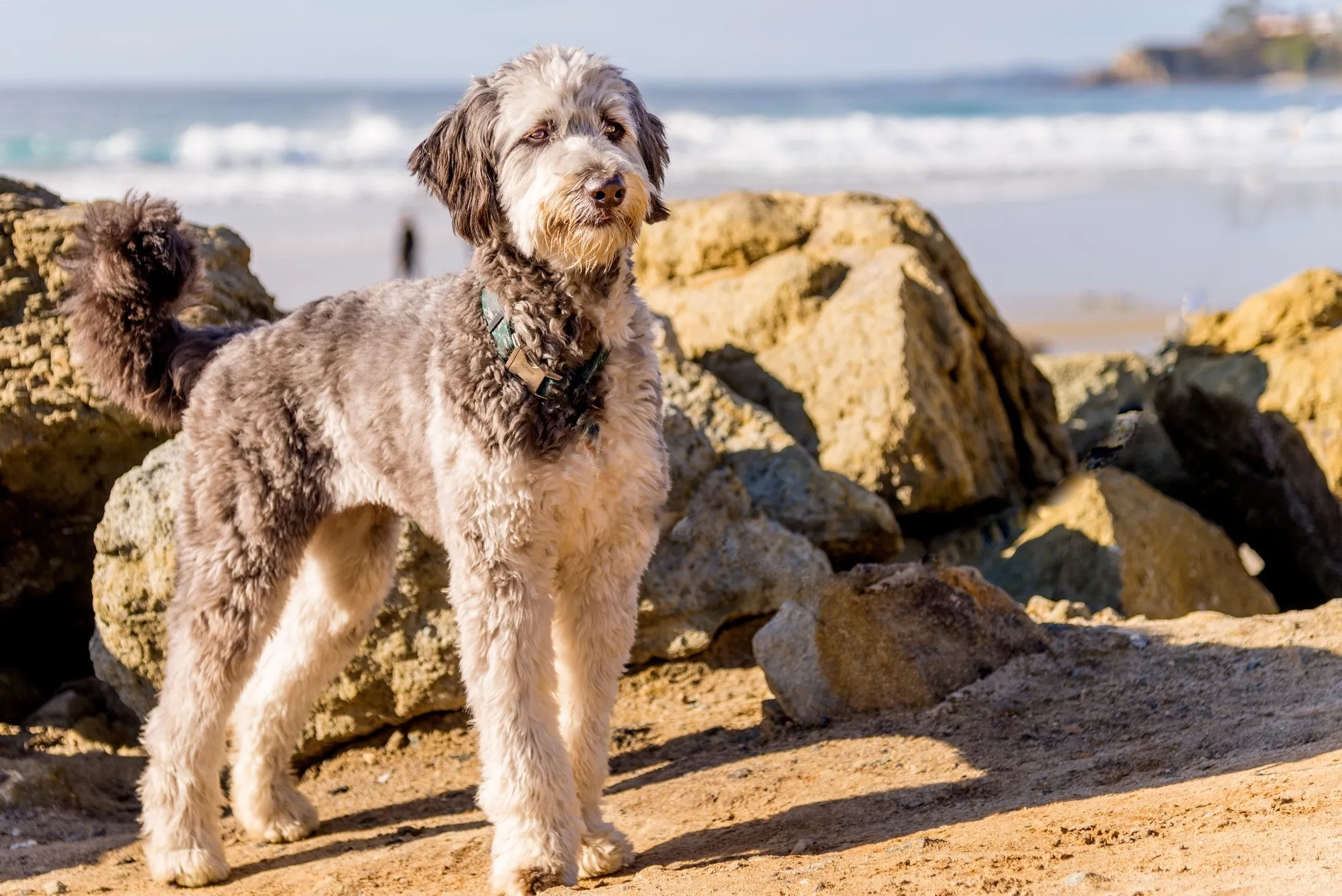 Standard Aussiedoodle dog standing on a sandy beachA lively cross between an Australian Shepherd and a Poodle, the Aussiedoodle is a highly intelligent and energetic dog with a low-shedding coat. They inherit a strong work ethic and a desire to please from both parent breeds. Aussiedoodles thrive on activity, requiring significant daily exercise and mental stimulation to prevent boredom and potential destructive behaviors. Puzzle toys and interactive games are great for engaging their keen minds. Their beautiful coats vary in texture and require regular brushing to prevent tangles. When considering such an intelligent and active breed, one might ponder which is the smartest dog breed that doesn’t shed for comparison.
Standard Aussiedoodle dog standing on a sandy beachA lively cross between an Australian Shepherd and a Poodle, the Aussiedoodle is a highly intelligent and energetic dog with a low-shedding coat. They inherit a strong work ethic and a desire to please from both parent breeds. Aussiedoodles thrive on activity, requiring significant daily exercise and mental stimulation to prevent boredom and potential destructive behaviors. Puzzle toys and interactive games are great for engaging their keen minds. Their beautiful coats vary in texture and require regular brushing to prevent tangles. When considering such an intelligent and active breed, one might ponder which is the smartest dog breed that doesn’t shed for comparison.
16. Bolognese
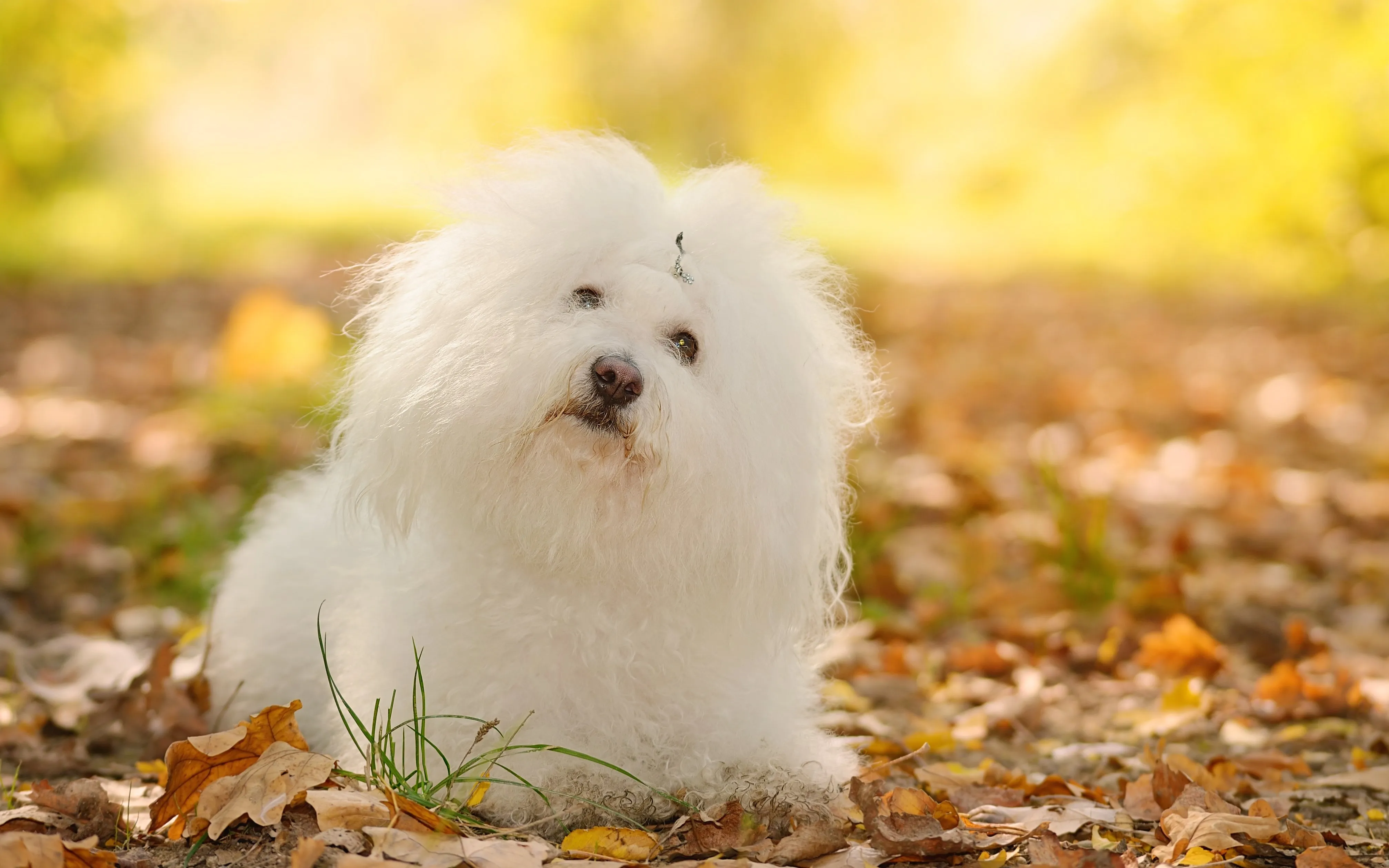 White Bolognese dog sitting in an autumn forestThe Bolognese is a charming, small breed originating from Italy, known for its long, fluffy white coat that, despite its somewhat messy appearance, sheds very little. These playful and easygoing pups are affectionate and adaptable, getting along well with children and other pets. They fit comfortably into various living situations, from apartments to larger homes. While their coat is low-shedding, it demands consistent grooming to prevent matting and keep it clean and healthy.
White Bolognese dog sitting in an autumn forestThe Bolognese is a charming, small breed originating from Italy, known for its long, fluffy white coat that, despite its somewhat messy appearance, sheds very little. These playful and easygoing pups are affectionate and adaptable, getting along well with children and other pets. They fit comfortably into various living situations, from apartments to larger homes. While their coat is low-shedding, it demands consistent grooming to prevent matting and keep it clean and healthy.
17. Maltese
 Woman holding a white Maltese dog on a bedMaltese dogs are elegant, small companions famous for their luxurious, flowing white coats that are also incredibly low-shedding. They are affectionate, playful, and devoted to their families, thriving on close companionship. Their exquisite coat requires daily brushing and regular professional grooming, especially if kept long, to prevent tangles and matting. Many owners opt for a shorter “puppy cut” to make grooming more manageable.
Woman holding a white Maltese dog on a bedMaltese dogs are elegant, small companions famous for their luxurious, flowing white coats that are also incredibly low-shedding. They are affectionate, playful, and devoted to their families, thriving on close companionship. Their exquisite coat requires daily brushing and regular professional grooming, especially if kept long, to prevent tangles and matting. Many owners opt for a shorter “puppy cut” to make grooming more manageable.
18. Soft Coated Wheaten Terrier
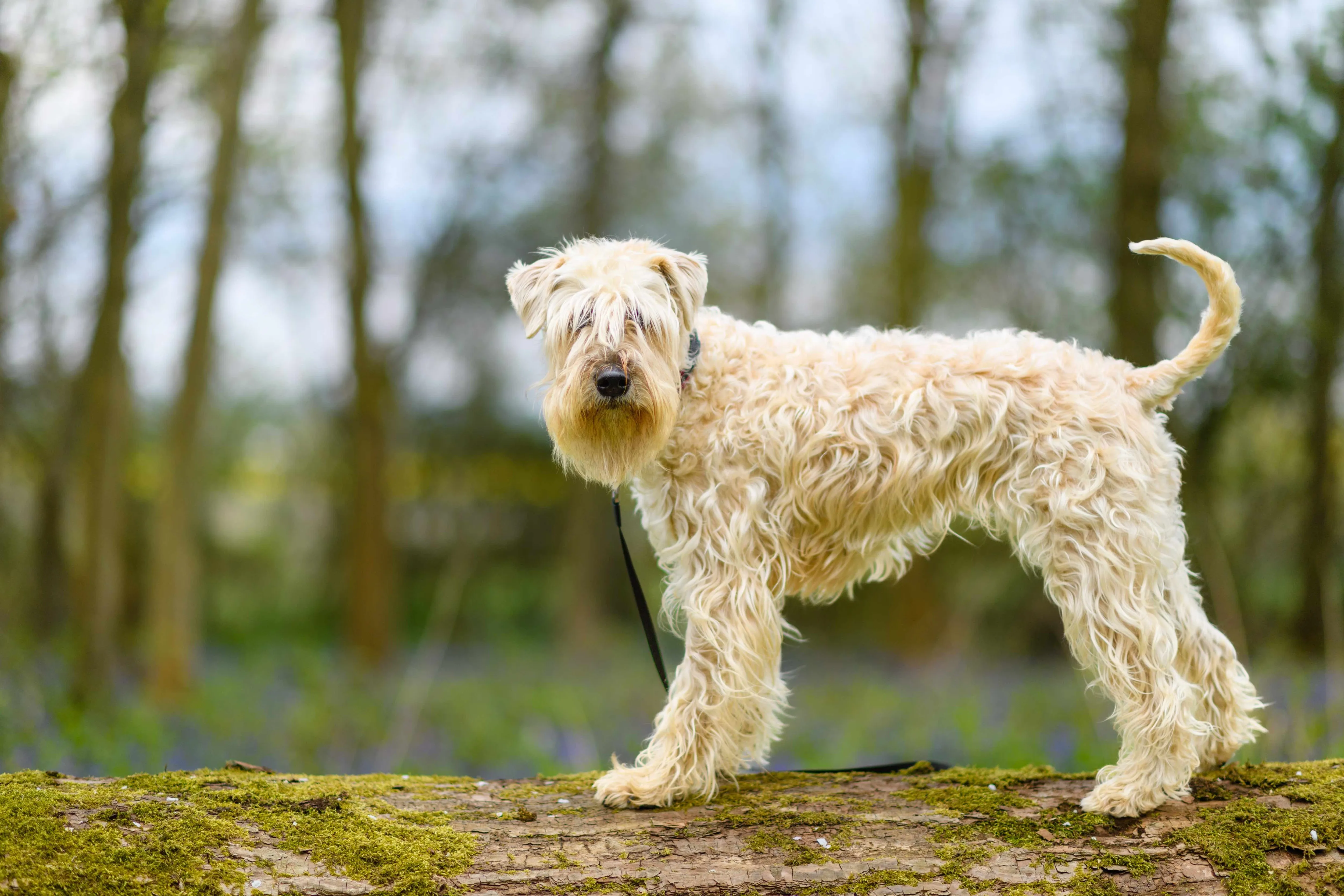 Soft Coated Wheaten Terrier dog sitting on a logThe Soft Coated Wheaten Terrier is a medium-sized Irish breed distinguished by its silky, soft, wheat-colored coat that sheds minimally. Wheatens are joyful, outgoing dogs with a lively and energetic temperament. As terriers, they maintain high energy levels throughout their lives and require ample daily exercise and mental stimulation to keep them well-behaved. Their unique single coat needs regular brushing to prevent matting and maintain its characteristic softness.
Soft Coated Wheaten Terrier dog sitting on a logThe Soft Coated Wheaten Terrier is a medium-sized Irish breed distinguished by its silky, soft, wheat-colored coat that sheds minimally. Wheatens are joyful, outgoing dogs with a lively and energetic temperament. As terriers, they maintain high energy levels throughout their lives and require ample daily exercise and mental stimulation to keep them well-behaved. Their unique single coat needs regular brushing to prevent matting and maintain its characteristic softness.
19. Coton de Tulear
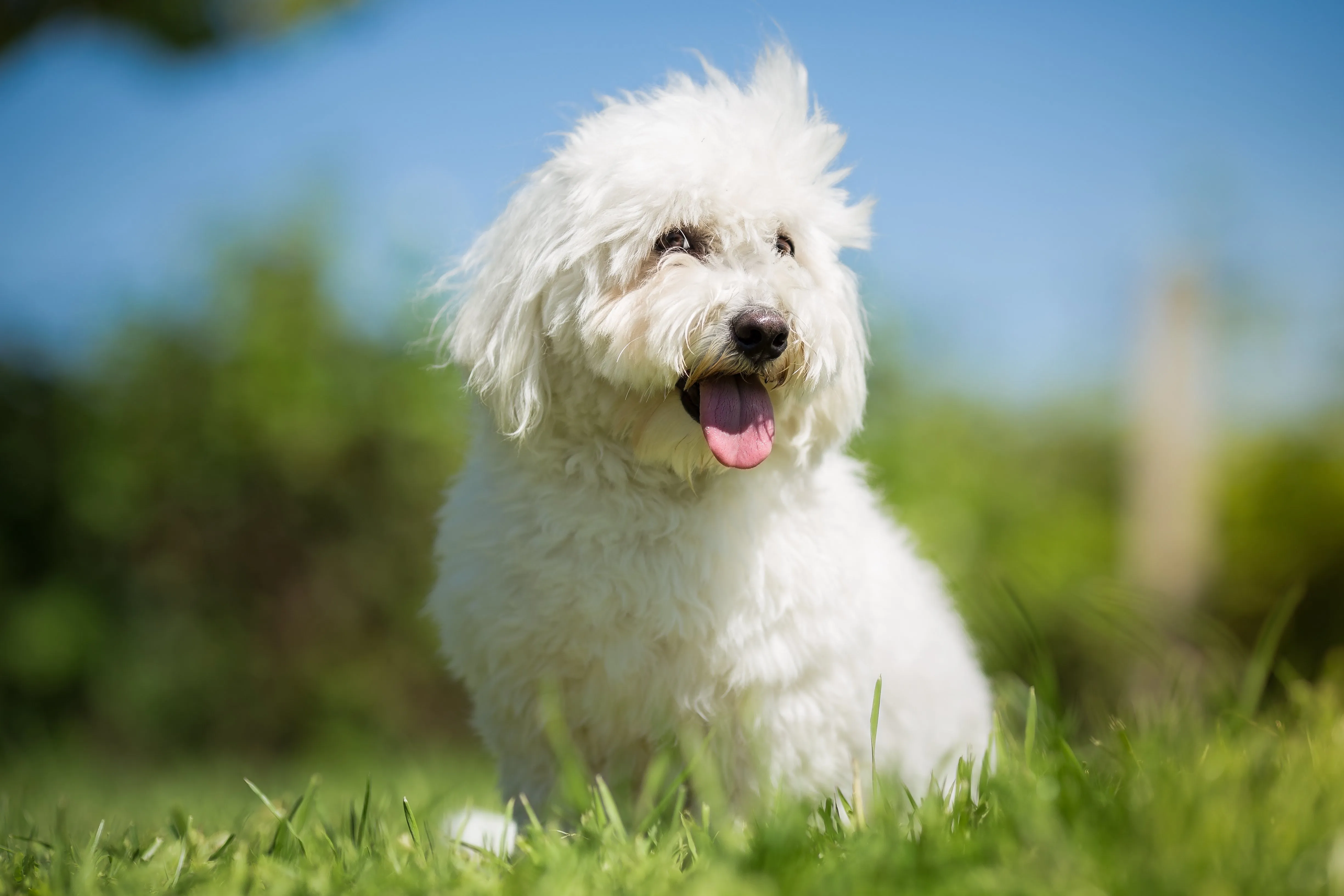 White Coton de Tulear sitting in grass with its hair blowing in the windOriginating from Madagascar, the Coton de Tulear is a small, easygoing, and exceptionally friendly breed with a soft, cotton-like coat that sheds very little. They are known for their charming personalities and adaptability, making them excellent family pets. Cotons generally get along well with children and other pets, especially when properly socialized from a young age. Their distinctive coat requires regular brushing to prevent matting and keep it clean.
White Coton de Tulear sitting in grass with its hair blowing in the windOriginating from Madagascar, the Coton de Tulear is a small, easygoing, and exceptionally friendly breed with a soft, cotton-like coat that sheds very little. They are known for their charming personalities and adaptability, making them excellent family pets. Cotons generally get along well with children and other pets, especially when properly socialized from a young age. Their distinctive coat requires regular brushing to prevent matting and keep it clean.
20. Schnoodle
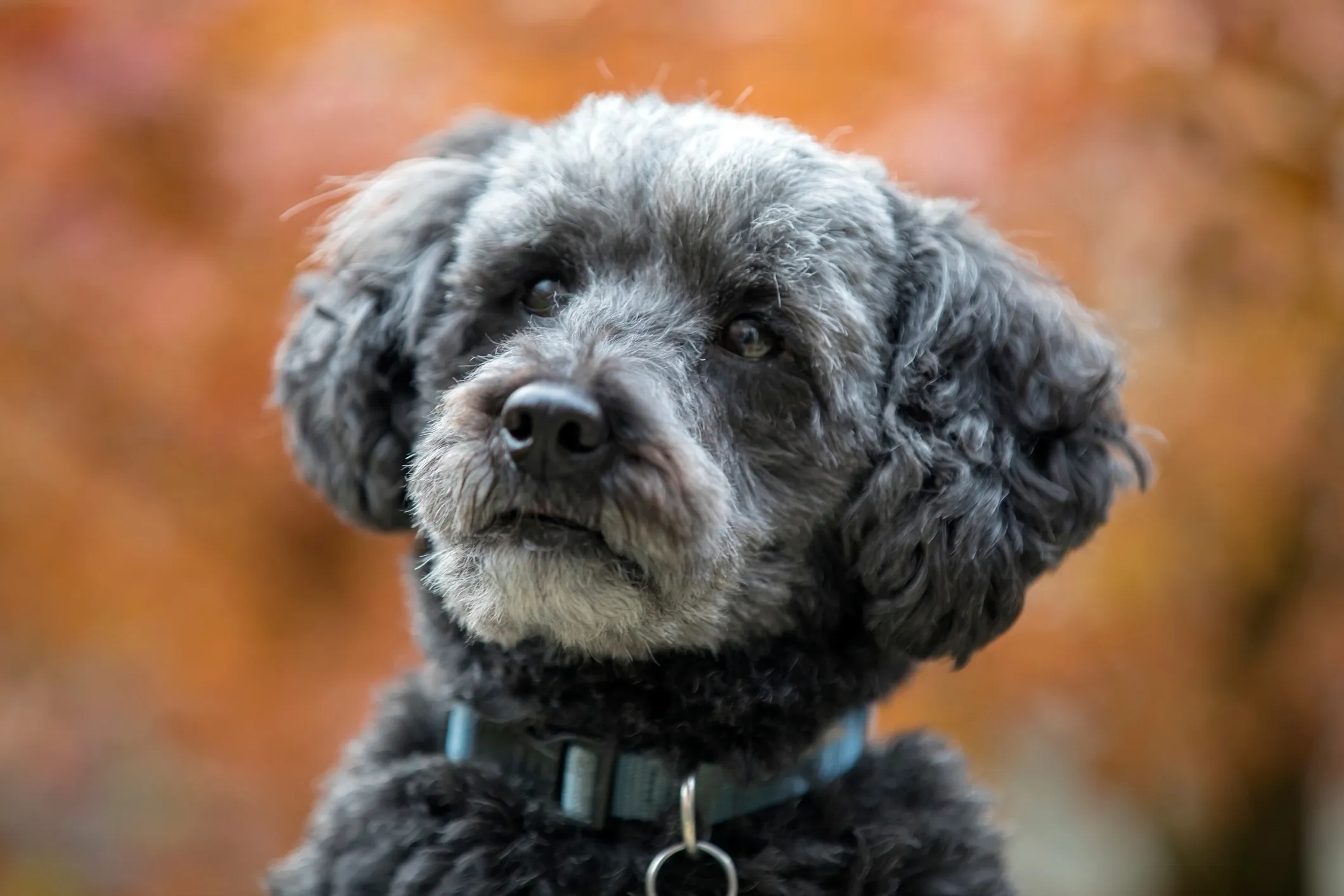 Close-up of a gray Schnoodle dogThe Schnoodle is a designer crossbreed combining two low-shedding parents: the Schnauzer and the Poodle. This makes them a strong contender for a truly “non-shedding” dog. Their coat can be curly or wavy, depending on which parent’s genetics are more dominant, but it is consistently low-shedding. Schnoodles are intelligent, playful, and affectionate, inheriting a blend of admirable traits from both breeds. They thrive on companionship and enjoy engaging in activities with their families.
Close-up of a gray Schnoodle dogThe Schnoodle is a designer crossbreed combining two low-shedding parents: the Schnauzer and the Poodle. This makes them a strong contender for a truly “non-shedding” dog. Their coat can be curly or wavy, depending on which parent’s genetics are more dominant, but it is consistently low-shedding. Schnoodles are intelligent, playful, and affectionate, inheriting a blend of admirable traits from both breeds. They thrive on companionship and enjoy engaging in activities with their families.
21. Bedlington Terrier
 White Bedlington Terrier running through snowOften described as “a lamb in dog’s clothing” due to its unique appearance, the Bedlington Terrier is a small, distinctive breed with a crisp, curly, low-shedding coat. They are known for their distinctive topknot and elegant arch over the loin. Bedlingtons are affectionate and loyal to their families, enjoying close companionship. They can be prone to separation anxiety if left alone for extended periods, making them ideal for homes where someone is usually present. While they are active and enjoy exercise, they are equally content cuddling with their people. Regular grooming is necessary to maintain their unique coat texture.
White Bedlington Terrier running through snowOften described as “a lamb in dog’s clothing” due to its unique appearance, the Bedlington Terrier is a small, distinctive breed with a crisp, curly, low-shedding coat. They are known for their distinctive topknot and elegant arch over the loin. Bedlingtons are affectionate and loyal to their families, enjoying close companionship. They can be prone to separation anxiety if left alone for extended periods, making them ideal for homes where someone is usually present. While they are active and enjoy exercise, they are equally content cuddling with their people. Regular grooming is necessary to maintain their unique coat texture.
22. Xoloitzcuintli
 Black Mexican Hairless Dog standing elegantly in grassAlso known as the Mexican Hairless Dog, the Xoloitzcuintli is an ancient and rare breed available in three sizes: toy, miniature, and standard. They can be completely hairless or have a very short, fine coat. Both varieties are considered hypoallergenic due to their minimal hair or complete lack thereof. Xolos are known for their calm, vigilant, and loyal nature, making them excellent companions and watchdogs. The hairless variety requires skin care, including sun protection and moisturizing, while the coated variety needs minimal brushing.
Black Mexican Hairless Dog standing elegantly in grassAlso known as the Mexican Hairless Dog, the Xoloitzcuintli is an ancient and rare breed available in three sizes: toy, miniature, and standard. They can be completely hairless or have a very short, fine coat. Both varieties are considered hypoallergenic due to their minimal hair or complete lack thereof. Xolos are known for their calm, vigilant, and loyal nature, making them excellent companions and watchdogs. The hairless variety requires skin care, including sun protection and moisturizing, while the coated variety needs minimal brushing.
23. Whoodle
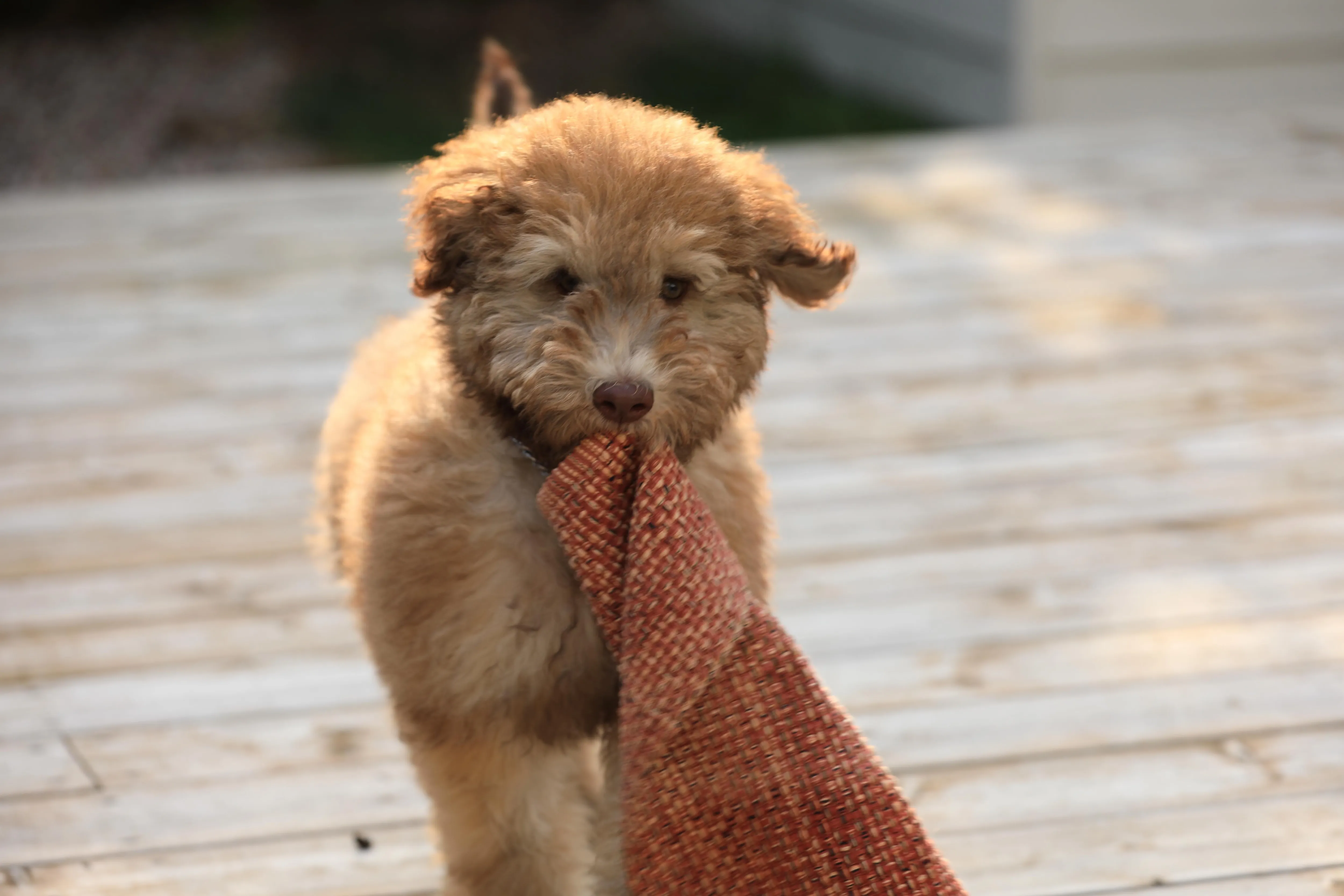 Tan Whoodle puppy playfully dragging a washclothA charming cross between a Soft Coated Wheaten Terrier and a Poodle, the Whoodle is a friendly, intelligent dog known for its soft, wavy or curly coat that sheds very little. They inherit an affectionate nature and intelligence from both parent breeds, making them highly trainable and wonderful family pets. Whoodles are energetic and enjoy play, requiring regular exercise and mental engagement to keep them happy and well-adjusted. Their coat needs consistent brushing to prevent matting.
Tan Whoodle puppy playfully dragging a washclothA charming cross between a Soft Coated Wheaten Terrier and a Poodle, the Whoodle is a friendly, intelligent dog known for its soft, wavy or curly coat that sheds very little. They inherit an affectionate nature and intelligence from both parent breeds, making them highly trainable and wonderful family pets. Whoodles are energetic and enjoy play, requiring regular exercise and mental engagement to keep them happy and well-adjusted. Their coat needs consistent brushing to prevent matting.
24. Bernedoodle
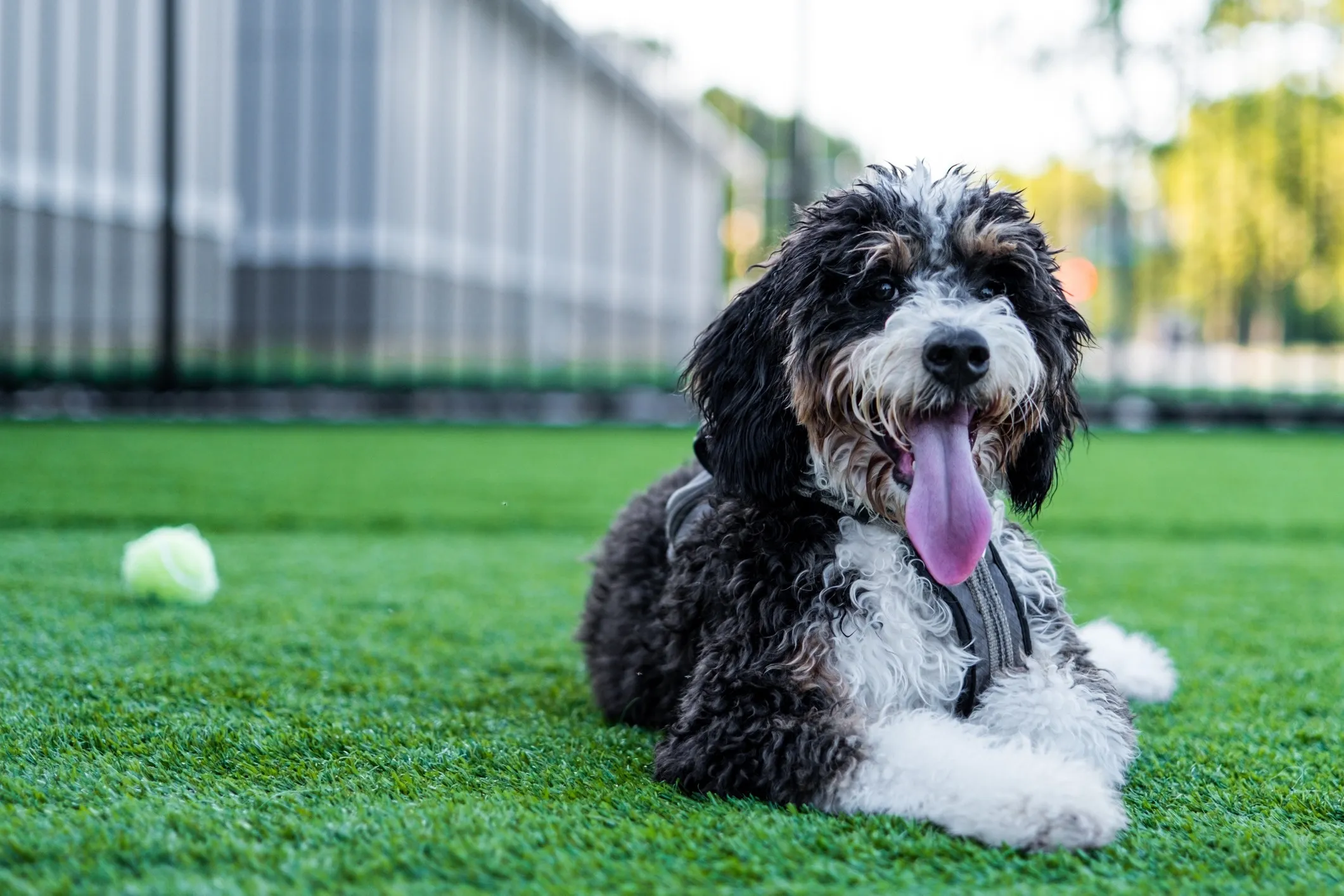 Large Bernedoodle dog lying in grass with its tongue outBernedoodles are a relatively new crossbreed, combining the gentle giant Bernese Mountain Dog with the intelligent Poodle. These large, affectionate dogs inherit a friendly and calm demeanor, making them popular choices for families with children and other pets. Their coats can vary from wavy to curly and are generally low-shedding, though some individual variation exists. Bernedoodles require regular exercise to maintain their health and happiness and thrive on being an active part of the family. Grooming is essential to keep their coats free of mats.
Large Bernedoodle dog lying in grass with its tongue outBernedoodles are a relatively new crossbreed, combining the gentle giant Bernese Mountain Dog with the intelligent Poodle. These large, affectionate dogs inherit a friendly and calm demeanor, making them popular choices for families with children and other pets. Their coats can vary from wavy to curly and are generally low-shedding, though some individual variation exists. Bernedoodles require regular exercise to maintain their health and happiness and thrive on being an active part of the family. Grooming is essential to keep their coats free of mats.
25. Shorkie
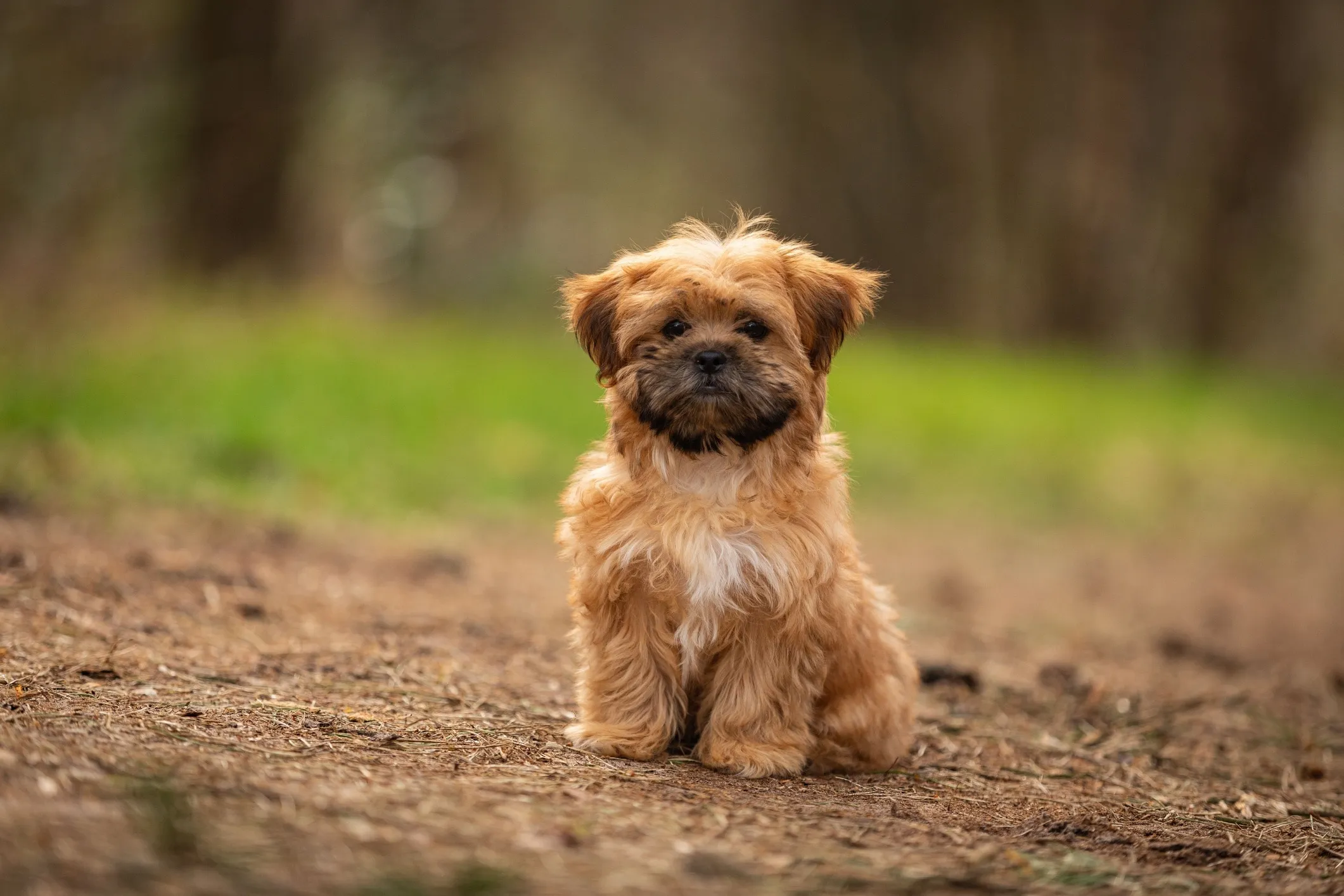 Tricolor Shih Tzu and Yorkie mix (Shorkie) sitting on a hiking trailThe Shorkie is a delightful mixed breed combining the affectionate Shih Tzu and the spunky Yorkshire Terrier, both of which are low-shedding breeds. This creates a small, playful, and friendly companion that embodies the best traits of both parents. Shorkies are adaptable and thrive on companionship, making them excellent lap dogs. Like most dogs with hair-like coats, they require a dedicated, regular grooming routine, including daily brushing to prevent tangles and professional trims.
Tricolor Shih Tzu and Yorkie mix (Shorkie) sitting on a hiking trailThe Shorkie is a delightful mixed breed combining the affectionate Shih Tzu and the spunky Yorkshire Terrier, both of which are low-shedding breeds. This creates a small, playful, and friendly companion that embodies the best traits of both parents. Shorkies are adaptable and thrive on companionship, making them excellent lap dogs. Like most dogs with hair-like coats, they require a dedicated, regular grooming routine, including daily brushing to prevent tangles and professional trims.
26. Afghan Hound
 Gray and tan Afghan Hound looking thoughtfully at the cameraAfghan Hounds are striking, aristocratic dogs known for their long, flowing, silky coats and slender, elegant builds. Despite their voluminous hair, they are considered low-shedding. Bred for speed and hunting in harsh climates, these sighthounds are built for running and require considerable exercise. They are loving and devoted to their families but can be aloof and independent, sometimes even reserved with strangers. Early and consistent socialization is vital for this breed to ensure a well-adjusted temperament. Their magnificent coats demand significant grooming to prevent matting and keep them healthy.
Gray and tan Afghan Hound looking thoughtfully at the cameraAfghan Hounds are striking, aristocratic dogs known for their long, flowing, silky coats and slender, elegant builds. Despite their voluminous hair, they are considered low-shedding. Bred for speed and hunting in harsh climates, these sighthounds are built for running and require considerable exercise. They are loving and devoted to their families but can be aloof and independent, sometimes even reserved with strangers. Early and consistent socialization is vital for this breed to ensure a well-adjusted temperament. Their magnificent coats demand significant grooming to prevent matting and keep them healthy.
27. Barbet
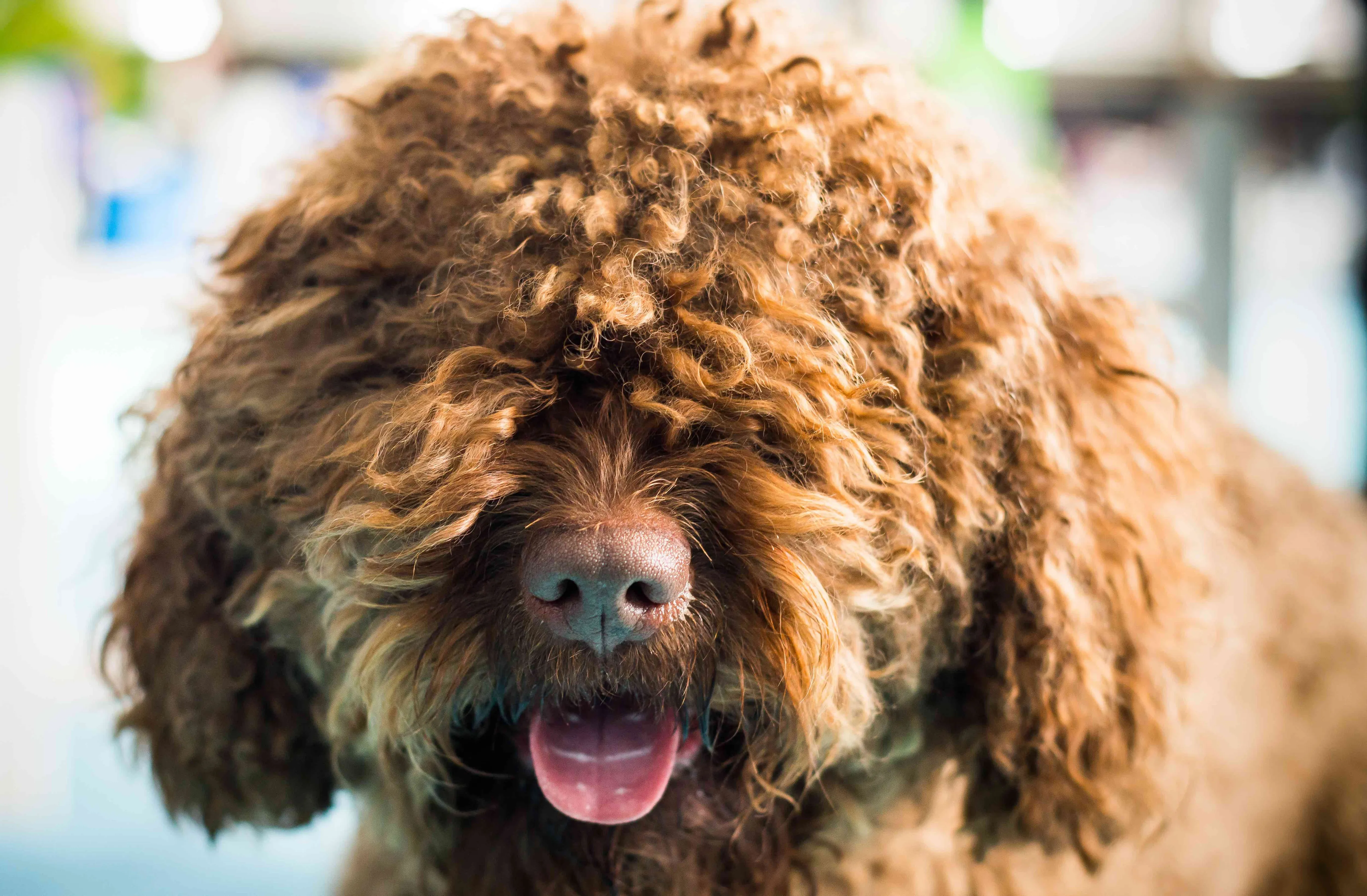 Close-up of a curly red Barbet dog face with its characteristic beardThe Barbet, pronounced “bar-bay,” is a cheerful and water-loving dog with a distinctive shaggy, woolly coat that sheds very little. The breed’s name is derived from the French word “barbe,” meaning beard, which points to their characteristically hairy chin. Barbets are intelligent, good-natured, and thrive on being active. Their protective curly coat makes them excellent swimmers. To maintain their coat in good condition, especially after swimming, they require regular brushing (two to three times a week) with a slicker or pin brush to prevent mats.
Close-up of a curly red Barbet dog face with its characteristic beardThe Barbet, pronounced “bar-bay,” is a cheerful and water-loving dog with a distinctive shaggy, woolly coat that sheds very little. The breed’s name is derived from the French word “barbe,” meaning beard, which points to their characteristically hairy chin. Barbets are intelligent, good-natured, and thrive on being active. Their protective curly coat makes them excellent swimmers. To maintain their coat in good condition, especially after swimming, they require regular brushing (two to three times a week) with a slicker or pin brush to prevent mats.
28. Shih-Poo
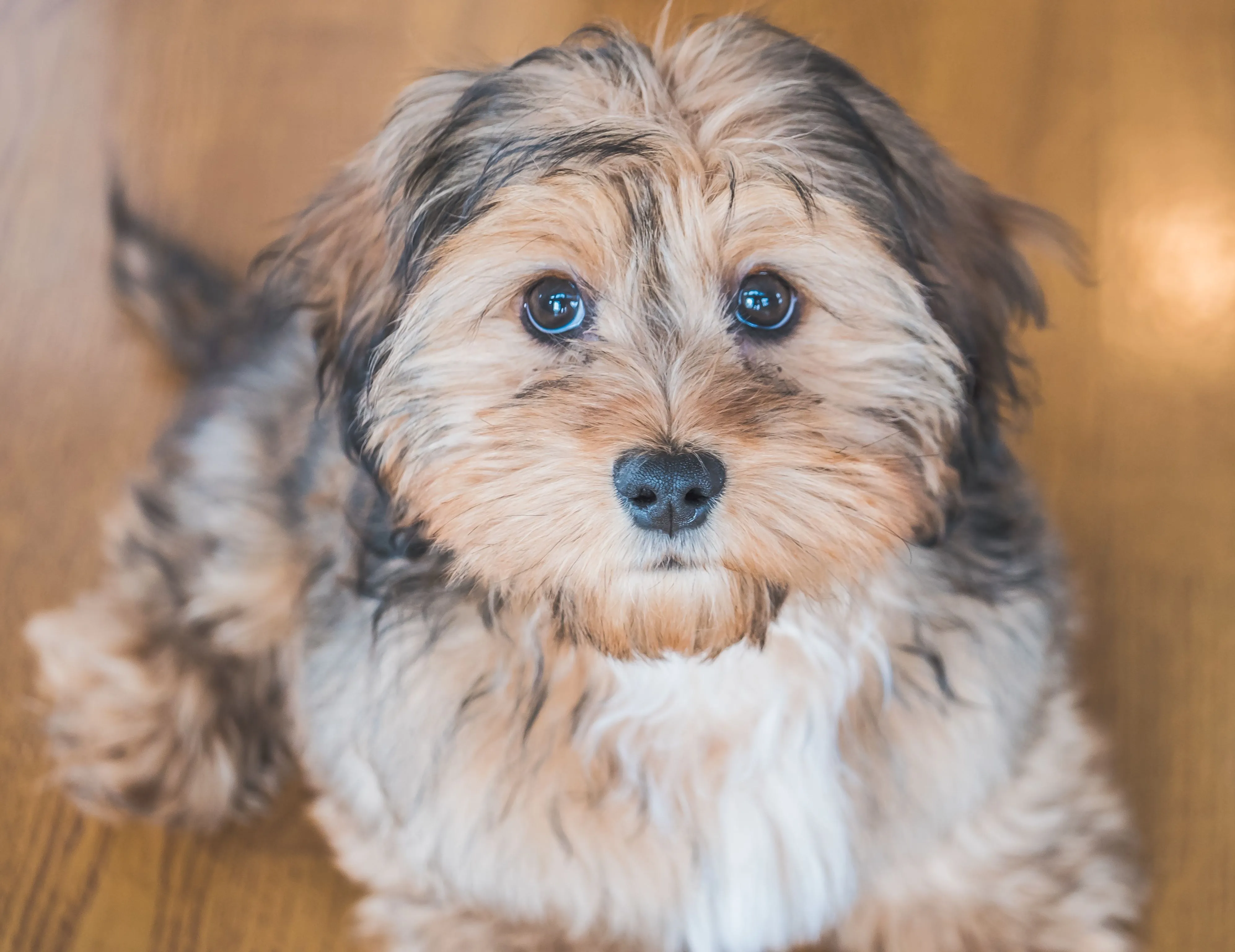 Tan and black Shih-Poo dog in a close-up portraitThe Shih-Poo is a charming mixed breed, typically a cross between a Shih Tzu and a Toy Poodle. This small, affectionate pup boasts a low-shedding coat and adapts well to almost any living situation, making them a popular choice for apartment dwellers. Shih-Poos thrive on companionship and require moderate exercise, usually around 30 minutes daily, along with regular brushing sessions to keep their coats tangle-free. Their friendly and outgoing personalities make them delightful family members. For general considerations about dog breeds and their unique requirements, including those beyond shedding, understanding all breeds of dogs price in india might offer a broader context for potential owners.
Tan and black Shih-Poo dog in a close-up portraitThe Shih-Poo is a charming mixed breed, typically a cross between a Shih Tzu and a Toy Poodle. This small, affectionate pup boasts a low-shedding coat and adapts well to almost any living situation, making them a popular choice for apartment dwellers. Shih-Poos thrive on companionship and require moderate exercise, usually around 30 minutes daily, along with regular brushing sessions to keep their coats tangle-free. Their friendly and outgoing personalities make them delightful family members. For general considerations about dog breeds and their unique requirements, including those beyond shedding, understanding all breeds of dogs price in india might offer a broader context for potential owners.
29. Peruvian Inca Orchid
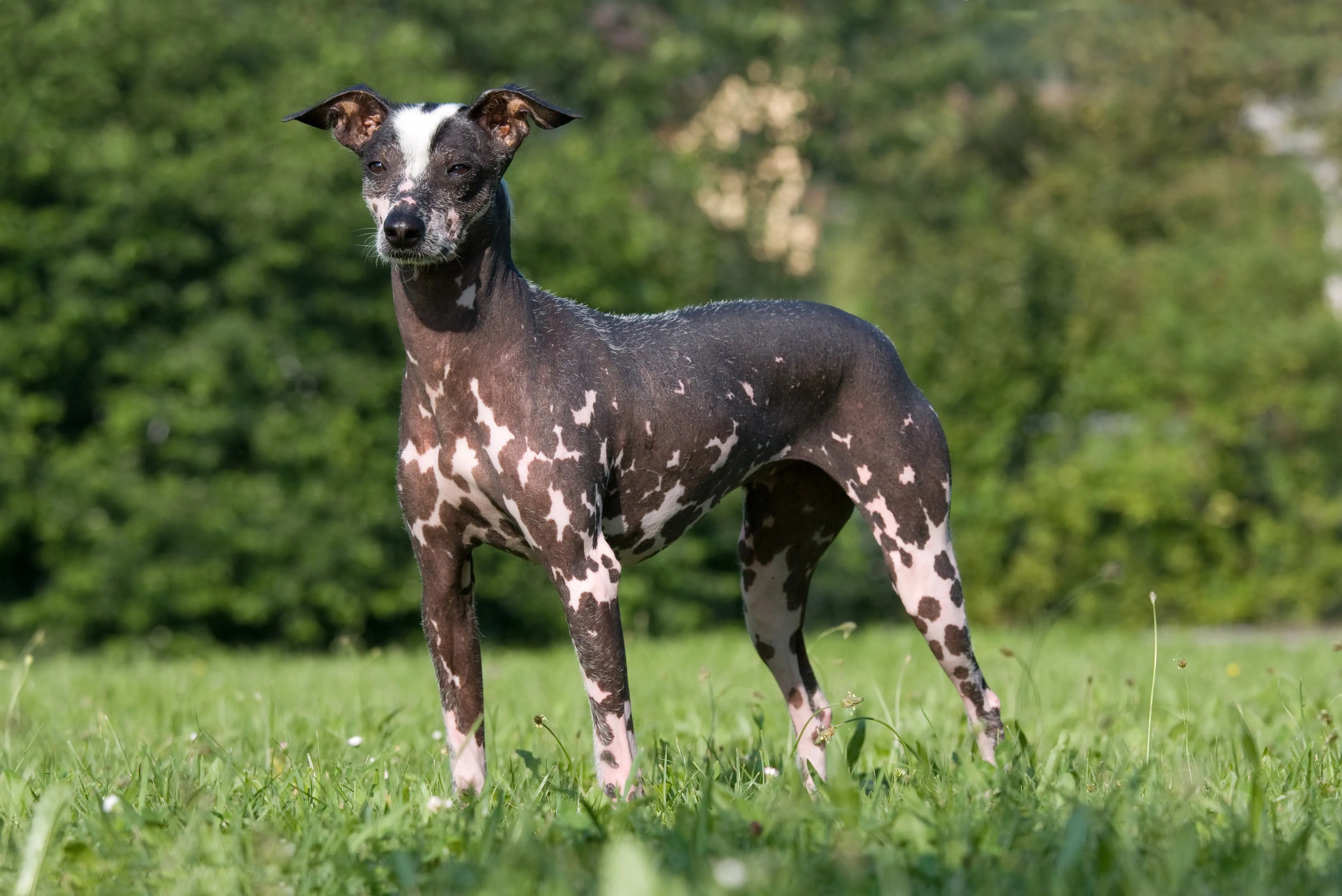 Peruvian Inca Orchid dog, showcasing its hairless bodyA rare and ancient breed from Peru, the Peruvian Inca Orchid is a truly low-shedding dog, thanks to its predominantly hairless body. While rare, they do come in three sizes (small, medium, and large) and are recognized as the national dog of Peru. They possess a noble and vigilant temperament, forming strong bonds with their families. The hairless variety requires diligent skin care to protect it from the sun and cold, while the very lightly coated version needs minimal grooming.
Peruvian Inca Orchid dog, showcasing its hairless bodyA rare and ancient breed from Peru, the Peruvian Inca Orchid is a truly low-shedding dog, thanks to its predominantly hairless body. While rare, they do come in three sizes (small, medium, and large) and are recognized as the national dog of Peru. They possess a noble and vigilant temperament, forming strong bonds with their families. The hairless variety requires diligent skin care to protect it from the sun and cold, while the very lightly coated version needs minimal grooming.
30. Malshi
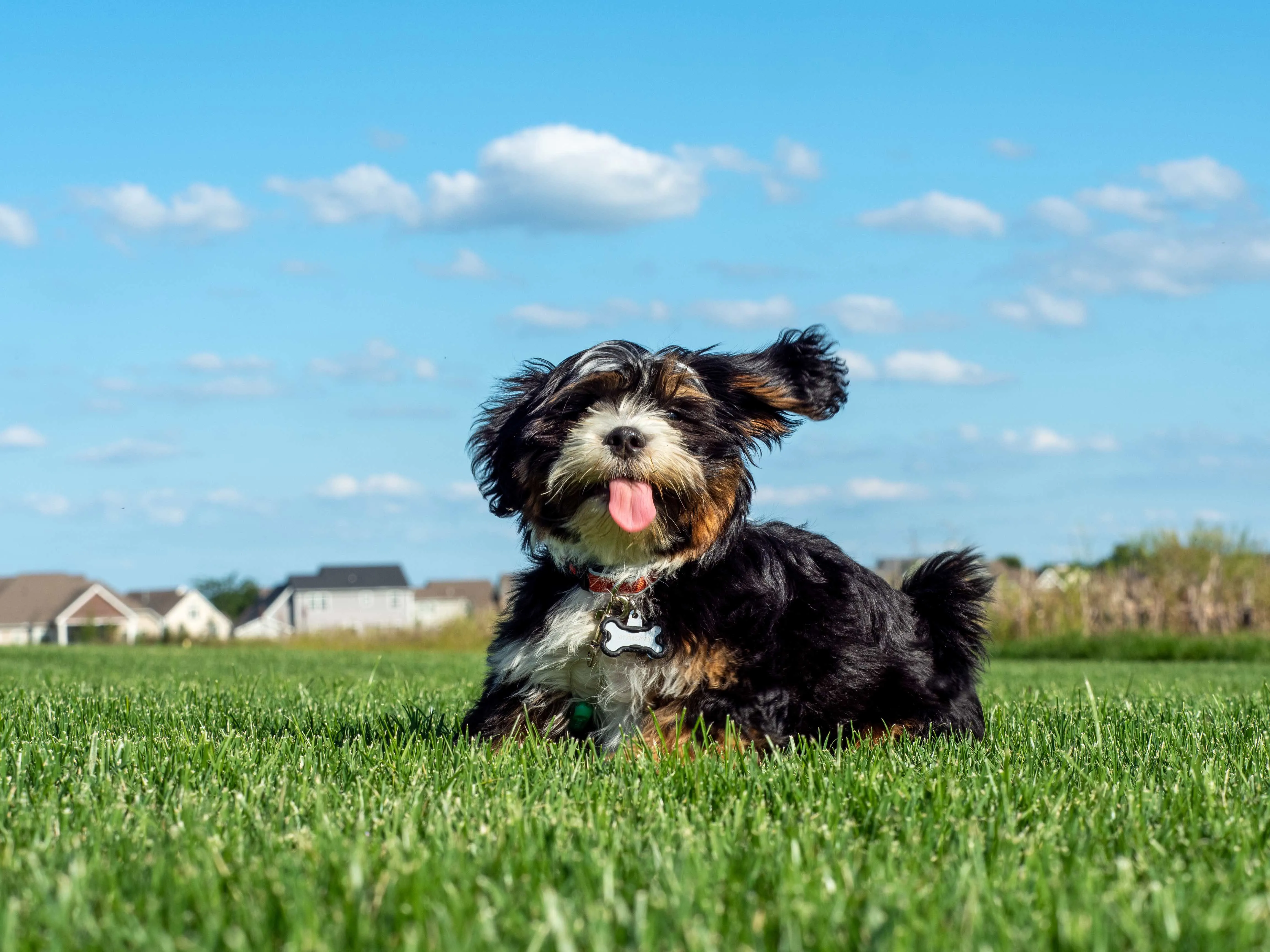 Tricolor Malshi dog sitting in lush green grassA delightful cross between the Maltese and Shih Tzu, the Malshi is a happy, small, and affectionate dog with a low-shedding coat. These charming companions thrive on human interaction and require close companionship to be truly content. Their friendly demeanor makes them suitable for families, though like their parent breeds, they do require a consistent and dedicated grooming routine to keep their soft coats healthy and tangle-free.
Tricolor Malshi dog sitting in lush green grassA delightful cross between the Maltese and Shih Tzu, the Malshi is a happy, small, and affectionate dog with a low-shedding coat. These charming companions thrive on human interaction and require close companionship to be truly content. Their friendly demeanor makes them suitable for families, though like their parent breeds, they do require a consistent and dedicated grooming routine to keep their soft coats healthy and tangle-free.
Living with a Low-Shedding Dog: Essential Care Tips
Choosing a dog breed known for minimal shedding is a great first step, but responsible pet ownership, especially for those with allergies, goes beyond just the breed. Here are crucial tips for a harmonious life with your practically “non-shedding” companion:
Consistent Grooming is Key
Even dogs that don’t shed “at all” require significant grooming. Their hair continues to grow, necessitating regular brushing to prevent matting and tangles, which can be painful for the dog and trap dander.
- Brushing: Daily or every-other-day brushing is often required, depending on the breed and coat type. Use appropriate brushes (slicker, pin, comb) recommended for your dog’s specific coat.
- Bathing: Regular bathing every 4-6 weeks helps remove allergens, dander, and dirt from their coat. Use a gentle, dog-specific shampoo. Some special dander-reducing shampoos can be beneficial for allergy sufferers.
- Professional Trimming/Stripping: Many of these breeds need professional grooming every 4-8 weeks to trim their coats or, in some cases, to be hand-stripped to maintain the coat’s texture and reduce shedding. Budget for these services or commit to learning how to groom your dog at home.
Maintaining an Allergen-Reduced Home
Even with minimal shedding, allergens will still be present. A clean home environment is vital for allergy sufferers.
- Regular Cleaning: Vacuum frequently with a HEPA-filtered vacuum cleaner. Dust surfaces regularly with a damp cloth to trap allergens. Wash bedding (both human and pet) weekly in hot water.
- Air Quality: Use high-efficiency particulate air (HEPA) purifiers in rooms where your dog spends the most time, especially bedrooms. Ensure good ventilation by opening windows when possible.
- Designated Pet-Free Zones: Consider making bedrooms pet-free zones to create an allergen-reduced sanctuary for sleeping.
Consulting Your Healthcare Provider
For individuals with dog allergies, managing symptoms is crucial for quality of life.
- Allergy Management Plan: Consult with your doctor or an allergist to discuss a comprehensive allergy management plan. This may include over-the-counter or prescription medications, nasal sprays, or allergy injections (immunotherapy).
- Minimize Direct Contact: While low-shedding dogs reduce overall allergens, remember that allergens are also present in saliva and urine. Try to avoid letting your dog lick your face and always wash your hands after handling your pet, especially before touching your face.
Bringing a low-shedding dog into your home can significantly improve the quality of life for individuals with allergies, offering the immense joy and companionship of a pet without constant allergic reactions. With proper grooming and home maintenance, these wonderful breeds can bring happiness and comfort to many families.
References
- National Institute of Environmental Health Sciences (NIEHS): Pet Allergens. (Information on dog allergens and their sources).
- PetMD: Various breed-specific articles and general dog health information. (Provided linked articles in the original).
- American Kennel Club (AKC): Breed standards and information for various dog breeds. (General reference for breed characteristics and care).
- Veterinary consensus on dog dander and allergy management. (General scientific and medical understanding in veterinary practice).
